"A sense of being. A sense of belonging,
that's what it was all about".
A Story Of The 60s Mods
In
Cheltenham and Beyond
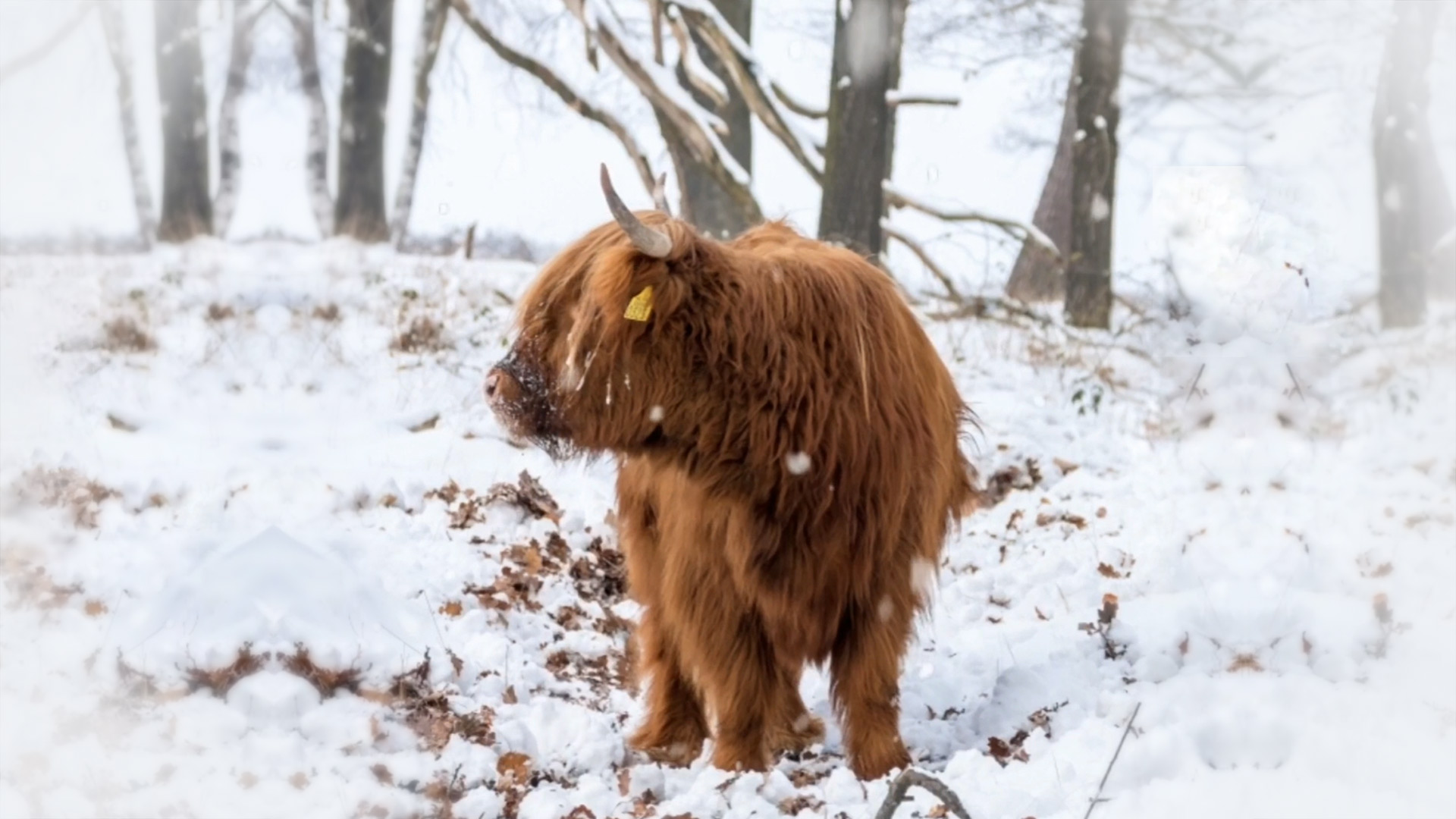
Cheltenham: An unlikely place for a fight?
The town of Cheltenham is probably not a place you would associate with gang violence. But over several nights in the autumn of 1965, groups of mods clashed with rival rockers in this historic regency town.
Tempers flared. Fights broke out. Arrests were made.
But who were these young mods?
Why were they brawling in the streets?
And more than 50 years on where are they now?
The Fight
The beautiful town of Cheltenham Spa sits on the edge of the Cotswolds. In the minds of many, it is full to bursting with retired sergeant majors strolling around and ladies in pearls enjoying bottomless brunches in the tree-lined promenade. The town is known for its stunning Regency architecture and its many festivals have attracted visitors for years. In a word Cheltenham is posh - and it appears that in 1965 things were not much different.
Appearances can be deceptive. Cheltenham may have seemed just a pleasant place to pass away the time in retirement, but in the mid -1960s there was also a thriving youth subculture in the town.
The mod movement that started in London in the late 1950s had spread quickly across the country to small towns such as Cheltenham. Mods wore sharp tailored suits, rode scooters and listened to bands like Small Faces and The Who.
They may have been poles apart from Cheltenham's typical image, but their fashion and musical tastes were also different to those of the rockers, another youth group in the town. Rockers preferred motorbikes and rock 'n roll. The two sides viewed each other with suspicion. There was animosity. Eventually, this spilled over into violence.
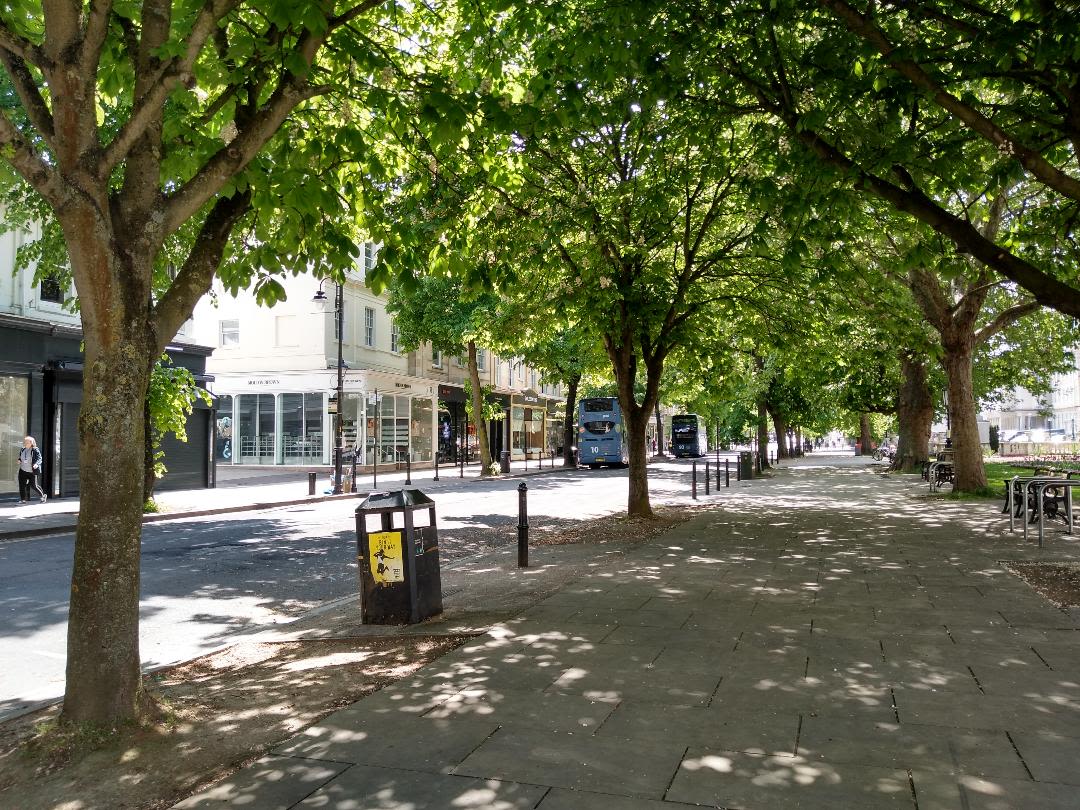
In 1965 trouble flared on the usually quiet streets of Cheltenham. Ongoing battles between rival groups of mods and rockers angered the community. The violence was sudden and unexpected, shattering the peace of the spa town and most notably captured the attention of the ATV regional television news.
Just one year earlier in 1964 Britain's young mods and rockers were locked in violent confrontations in seaside resorts across the UK. They didn't understand each other and had absolutely nothing in common. The simmering tensions between them exploded on the beaches of Brighton, Margate and Clacton on the May Bank holiday. The press had a field day reporting the public outrage. This coverage led sociologist Stanley Cohen to coin the phrase "Moral Panic" for what he viewed as the exaggeration and blame encouraged by the nation's media.
The Cheltenham clashes continued for a number of nights much to the frustration of the locals. In a letter to the editor of the Gloucestershire Echo, one disgruntled resident even recommended: "a spell in the army would knock sense into their empty heads".
The news report also featured two young mods, Patti Garland and Graham Williams.
Both were interviewed by David Lloyd and revealed exactly what they thought about the rockers and the trouble.
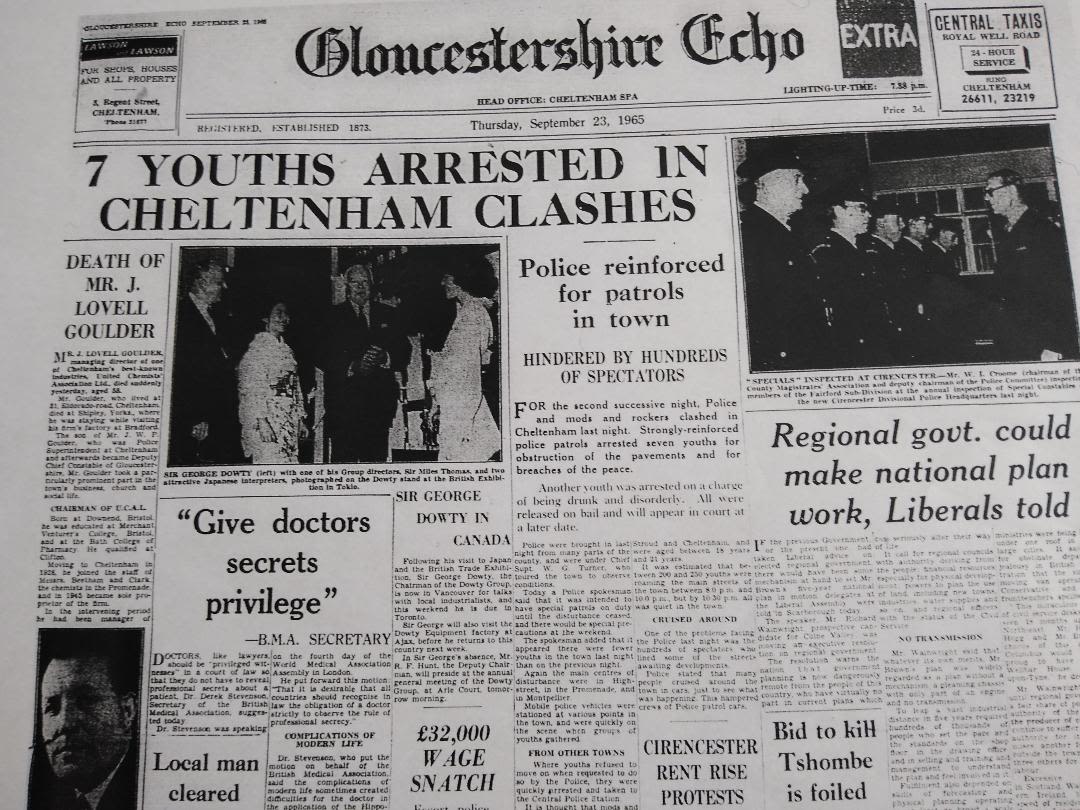
Source: Gloucestershire Echo Archive
Source: Gloucestershire Echo Archive
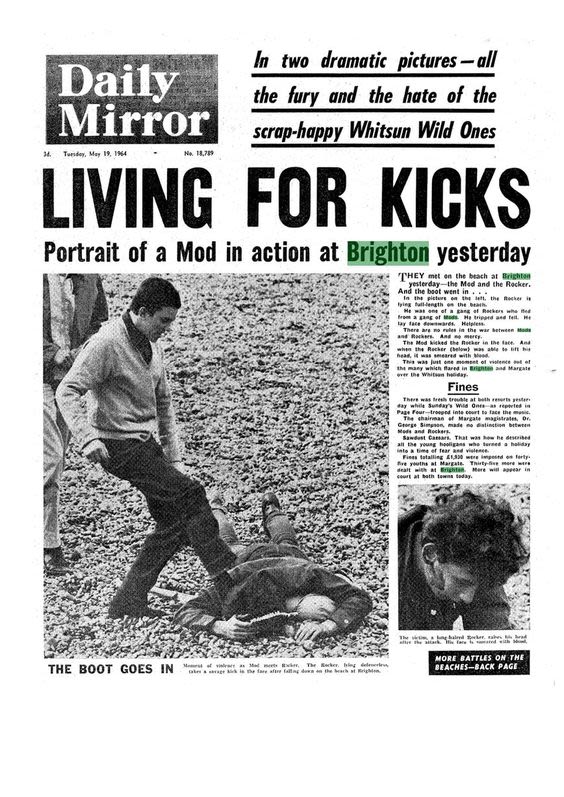
"This was just one moment of violence out of the many which flared in Brighton and Margate over the Whitsun holiday" Source: Daily Mirror Tuesday May 19th, 1964, No. 18, 789 British Newspaper Archive
"This was just one moment of violence out of the many which flared in Brighton and Margate over the Whitsun holiday" Source: Daily Mirror Tuesday May 19th, 1964, No. 18, 789 British Newspaper Archive
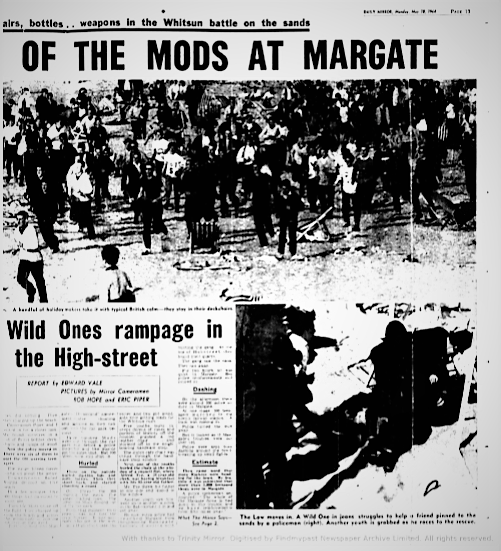
"We found ourselves in a riot of flying bottles, deck chairs and lumps of wood". Source: Daily Mirror Monday May 18th 1964 British Newspaper Archive
"We found ourselves in a riot of flying bottles, deck chairs and lumps of wood". Source: Daily Mirror Monday May 18th 1964 British Newspaper Archive
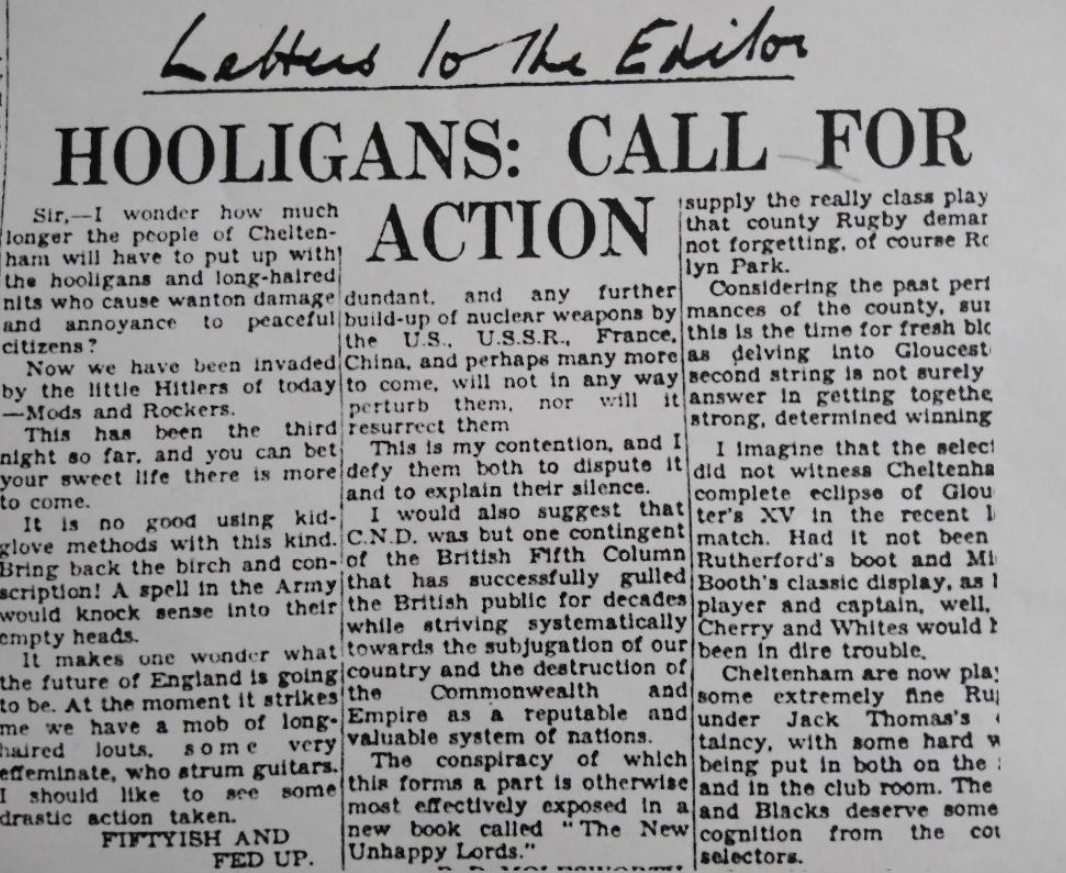
"Bring back the birch" Source: Gloucestershire Echo Archive
"Bring back the birch" Source: Gloucestershire Echo Archive
Graham's Story
“You have to remember it was bleak. It was only twenty years after the war and every young guy dressed like his Dad. Grey, blue black. We brought the colour”.
That Was The Way It Was
One of the young mods who appears in the film is the late Graham Williams who sadly passed away in April 2021. As a boisterous 20-year-old in 1965 he is worried about his "old man listening" and in an effort to disguise himself has donned an ill-fitting hat. He turns his face from the camera in an attempt to, not very successfully, mask his identity. Graham gave the following interview from his Cheltenham home in March 2020.
"I didn’t even know it was going on until somebody actually pulled me out of the crowd and the next thing I know I’m in front of this bloke. I was pretty right about it really" he said, referring to what he told David Lloyd so many years ago.
"I mean this question of if they jump on you you’re going to fight back, you’ve got to haven’t you? That was the way it was".
Some fifty years later, Graham believed the fear of his father finding out stemmed from the attitudes of the day. Judging by the opinions of some of the local residents in the film, it was a valid fear.
"You could tell by the old ladies that were sitting there having a cup of tea. That was the way it was. My old man well he was just set in his ways. Everything had to be done by the book. I wasn’t scared alright because I would have laughed it off but I didn’t want to be answerable for it to be honest".
In those days corporal punishment was commonplace. The practice was banned in all schools by 1998. But back then it was acceptable which is possibly why one of the residents even suggested the return of the cat-o-nine tails as a solution to the problems.
"I’m sure she was teaching me at some time and using it". Graham joked. He admitted to "being chopsy" in his younger days and "author of my own misfortune" which often brought trouble his way. At grammar school, he remembered frequently getting the cane but acknowledged that it was "different times".
"If you did something wrong your neighbour would tell your Dad then you’d be in trouble with your Dad. My father never whacked me at all, ever, never but if he told you off, you didn’t like it so you know I didn’t do anything wrong not until I got to that funny stage. The bloke asking me…I said I can’t my old man might be watching”.
"I could tell you a story"
“That night with the mods and rockers when hundreds of them all came from everywhere Bristol, Birmingham, wherever and they drove up and down the street, you could hear it”. Graham said.
He explained how the trouble only started as a result of an earlier scuffle on the same evening. He and a friend were standing outside the Blue Moon when a rocker walked by hurling abuse. With animosity already there between the two groups, this inevitably led to a fight but then Graham thought nothing more about it.
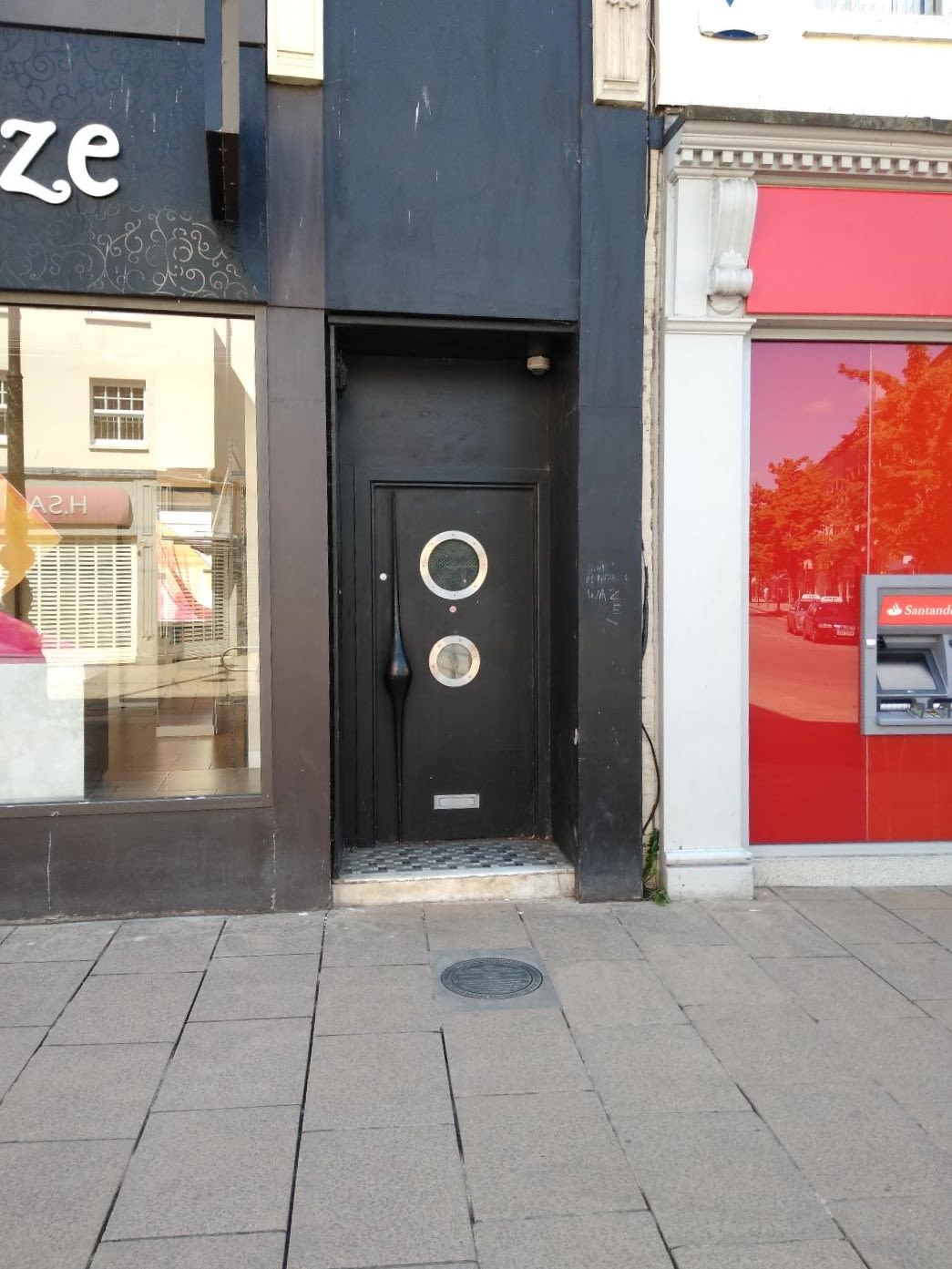
Doorway to the old Blue Moon site today. 2020
Doorway to the old Blue Moon site today. 2020
“Anyhow, we went back up the Moon quite happy with ourselves and somebody said look out the window and we looked out the window and there was about 100 rockers out there waiting for us. So what they said about ten people beating somebody, it's nonsense”, he said.
Graham insisted the rocker only said that because he was too embarrassed to admit he’d been beaten up by "two little mods".
Brawls would break out between the gangs every so often but not on the scale that brought the regional television news to cover the story.
“It wasn’t frequently alright, now and again. Sometimes they’d jump on you, and other times you could see it was gonna go off so in you went”.
The fights happened against a backdrop of violence and disruption in the wider world. They were unsettling times.
“It was such a disruptive period that the sixties. 65 on. Every day for about seven years the television was invaded by what was going on in Vietnam. Now that was massive and you also had all the big riots going on in LA and all over the place”.
The Vietnam War had been raging for 10 years (a conflict that lasted for more than 19 years and would not end until 1975) and the Watts race riots in LA which saw six days of civil unrest in August 1965 and resulted in 34 deaths and $40 million in property damage.
"We didn’t take it; do you know what I mean? The generation there, my generation, we didn’t want it so we actually did something about it".
“Shit your Dad Wears”
Britain was in a post-war era. In his book 'Mods. A Way of life', Patrick Potter points out that men of this era were not generally followers of the latest trends. There was no concept of the standard suit of the day going out of fashion or becoming obsolete. The 1940s saw the mass production of menswear, albeit in conservative styles, and clothes were cheap but boring. The noticeable difference between men's and women's clothing of the time was the total absence of fashion. This absence led Potter to compare the stifled image to "shit your dad wears" as up until the sixties a man’s attire was generally restrained and entirely bereft of any colour or style.
“It was bleak – that’s right", Graham agreed, "The kid left school at 15 and he’s got an apprenticeship somewhere or whatever and the next day he’s dressed like his dad. You know he’s gone from school clothes on and then he’s dressed like his dad. Big long mac and trilby shoved on his head - all brown, grey, or sort of blue - that was it. It was dull”.
The inevitability of how things were is echoed by Charles Scarrott, another young mod living in the town.
"When you were 15 you got your first pair of long grey trousers and a check shirt and you got a job in the drawing office or as an apprentice or the civil service and married your girlfriend".
The emergence of the Mods, the first British youth culture, was to change all that. "All the elements were there", Potter says, "in a way that made the Teds look like a prototype, a trial run".
“Teddy boys, they were really really bright", Graham recalled, "they would stand out and all that but once they’d finished there was no colour, you couldn’t see any colour, everything was drab and of course, people got fed up with it.”
But in the early sixties, Charles said, "all of a sudden the world changed" and with that shift came new opportunities.
"You were a boy from Cheltenham, I was the first member of my family to go to university, you could go anywhere, get a job, you could move up the social ladder, you could become anybody. I had a car, I had money, I loved and adored clothes, and dressing up. All those things were caught up in that moment in Cheltenham; the look, the feel, the attitude".
The Mod Way Of Life
Graham left the air force in 1965 and soon discovered his passion for the mods and the music. They used to meet at a little coffee shop for espressos at the top of the promenade from where they would go on to clubs or to the local college to watch live gigs.
“Spencer Davis was there, I saw him when he was about…he was either 14 or 15, absolutely tremendous. Unbelievable. Before the Blue Moon opened. It was the music that drew me to it, I liked the music of the time, and a very good friend of mine was into it as well”.
His love for R&B and blues music saw him going down to London and travelling to other towns and cities to catch his favourite groups.
As a young mod Charles would also make regular trips to other venues so as not to miss out on the music. Times were changing and the music and clubs served as a meeting ground for young 16 to 20-year-olds. All over the country their newly found sense of freedom in post-war Britain pushed the mod movement forward.
"The idea of mod culture was a sort of thing that sprang up all over the place at about the same time and this was at a time when there was no social media, no TV coverage, you didn’t know unless you went and saw it". he said.
Meanwhile, back in Cheltenham, there were some pretty big names topping the bill at the Blue Moon.
“Jimi Hendrix was good, I saw him at the Blue Moon and always The Who. The Who always gave a good performance". Graham said.
He told the story of going for a drink with the group at the nearby Star pub before the gig, something which would be impossible today.
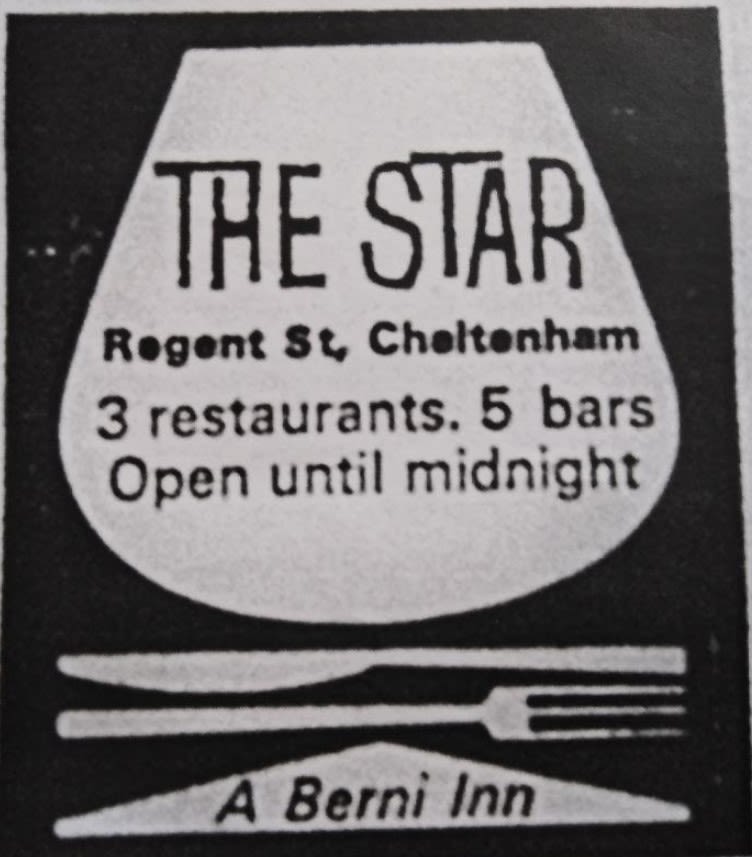
Image: Gloucestershire Echo Archive
Image: Gloucestershire Echo Archive
"We went in there and we had a drink and we were just chatting to them, then they went on stage. They all carried their own kit up the stairs, two flights of stairs”, he chuckles,
“And they had to take it back down after they’d finished because they were off somewhere else”.
The only two groups to never play at the Blue Moon were The Beatles and The Rolling Stones as by that time they were well on their way to global superstardom. Both played at the nearby Odeon cinema instead.
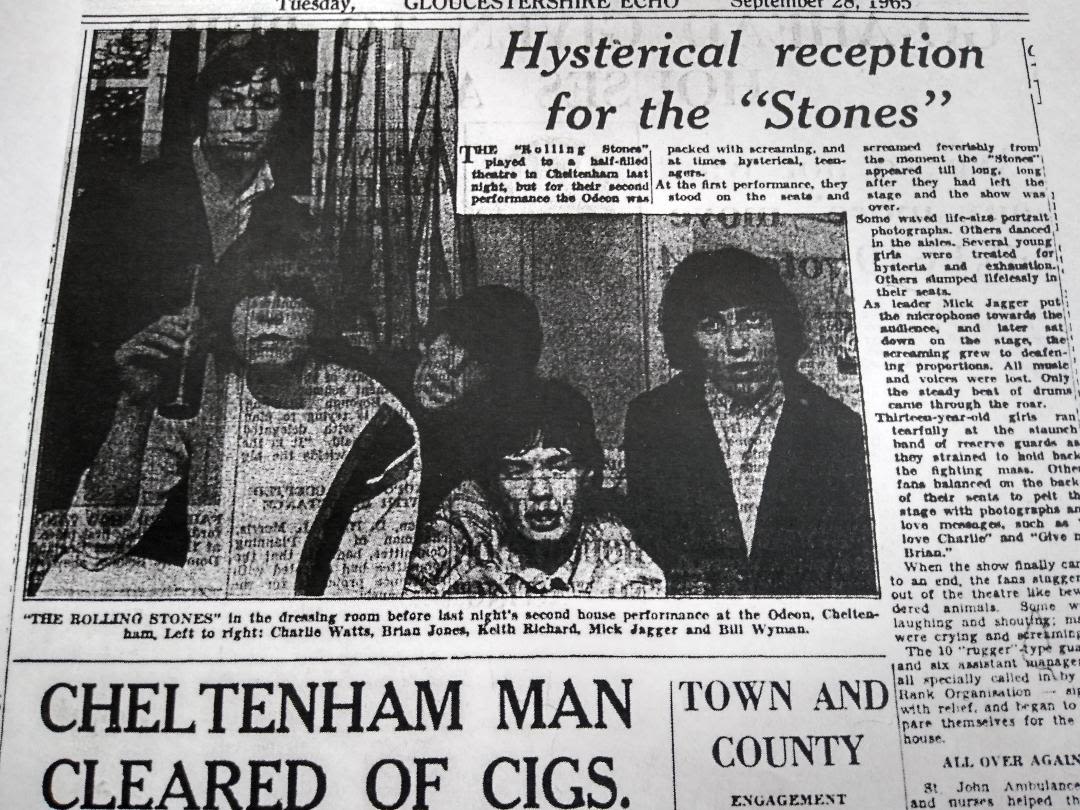
Images: Gloucestershire Echo Archive
Images: Gloucestershire Echo Archive
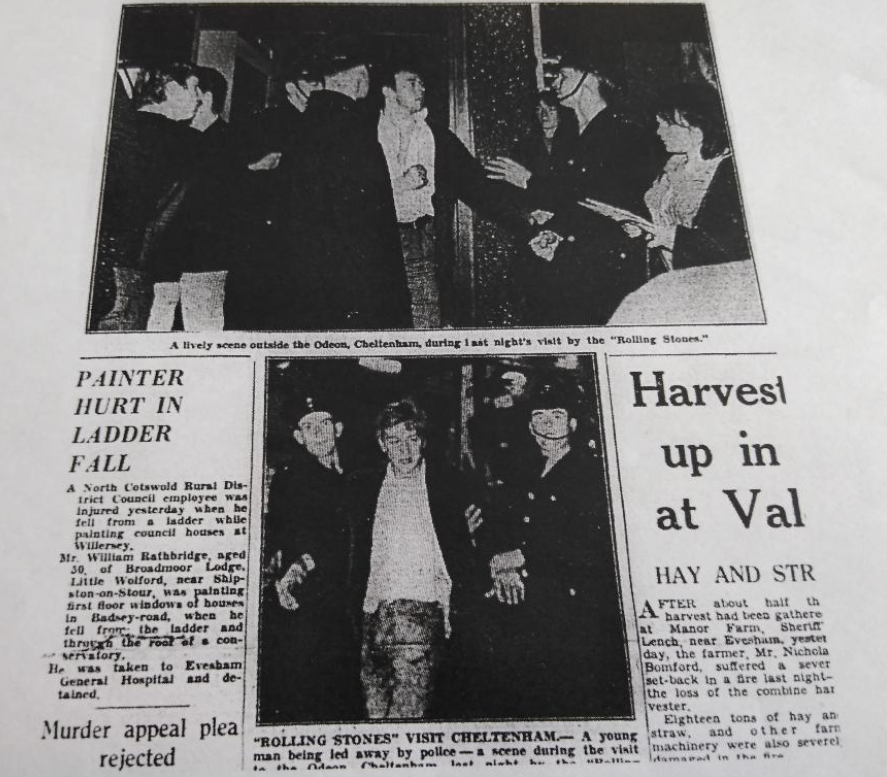
The artists and groups were much more accessible in the days of the club; difficult to imagine in today's music industry. Fans could meet their idols with ease and get close to those they admired the most. You were able to talk to them and it was friendly wherever you were.
“And the stage, you walked up to the stage, you could touch whoever you wanted to. Cor blimey!" Graham said, his voice full of joy at the memory. It was also vital to look your best he told me. “You had to be smart and looking good”, and getting spruced up for an evening had more than one benefit. " you could pull birds then couldn’t you?” he said.
In 1963 Ready Steady Go hit the nation's television screens bringing with it a live audience of “top faces” from the London mod scene; a time that Graham remembered only too well.
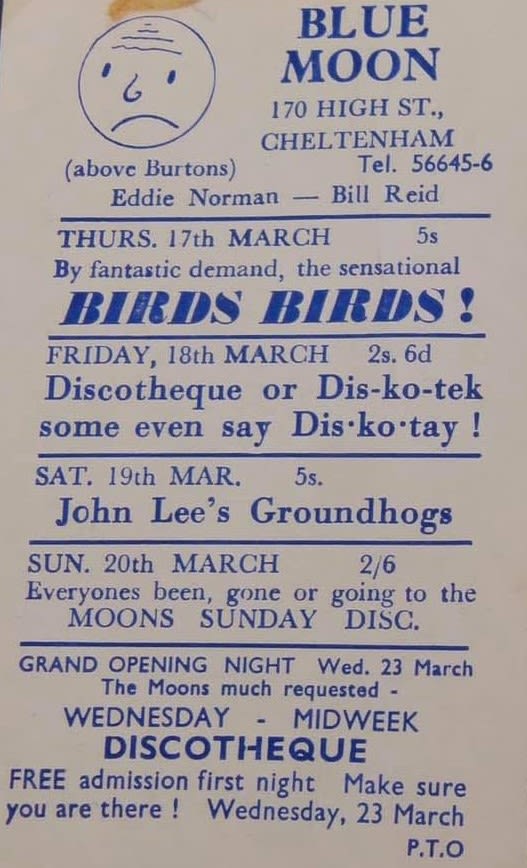
Image courtesy of The Blue Moon Cheltenham.Teen & Twenty Rendezvous Facebook group
Image courtesy of The Blue Moon Cheltenham.Teen & Twenty Rendezvous Facebook group
“It was a magical time, it was a time when you watched pop programmes on the TV, okay and you could say I’ve seen them, I’ve talked to them. It was fun".
“It was really good for the times you know. It was the best music, and they had a lot of black artists as well come over from America. The music was great. That was the standard”.
Graham reeled off a list of his top live acts that played the club. “They had Long John Baldry, one of the big blues people and there was also Alan Walker, and then you had Discotheque, John Lee and the Groundhogs, Spencer Davis and then you could go on to Geno Washington, they loved him. Lee Dorsey – I remember him, “Working down a coalmine”. The best of the lot were Steam Packet they were just absolutely brilliant. Long John Baldry, Julie Driscoll, Rod Stewart, and Brian Augur. They were absolutely fantastic I kid you not”.
The Gaumont which later became the Odeon Cinema.
The venue played host to the Beatles in 1963 and in 1965 The Rolling Stones came to town. The police feared the concert would be a flashpoint for further trouble and took action to avoid it.
The Odeon site as it is today.
Patti and Chris
"Mods came with a completely different style in clothes, music and lifestyle".
Patti Garland is seen in the ATV news report with her boyfriend and future husband Chris. In 1965, both had a flair for fashion and an innate sense of style and were known as Faces. Chris who passed away in 2018 was generally considered to be the 'King of the Mods' in the town.
Speaking from her London home more than fifty years later Patti said, “He worked in the first male boutique in that part of the country, Royden Esq which sold the most stylish mod gear. I moved to Cheltenham a short time before this and was also considered very stylish as I made all my own clothes at the time".
"Up until this time, there were only teddy Boys which were an earlier version of the rockers who liked rock ‘n’ roll and Elvis Presley. Mods came with a completely different style in clothes, music and lifestyle".
Being part of the Cheltenham mod scene and wider youth culture was of great significance for them both she explains,
"It was probably one of the most important times in our lives”.
A lost pair of sunglasses sparked the beginning of their romance.
David Lloyd's news report was not something that Patti had expected to be part of and only saw the original film a couple of years ago.
"I think it was because Chris was a pretty forward person. We just happened to be at the top of the promenade in Montpellier. The ATV evening news was there and they sort of homed in on us and I’m not entirely sure why but it could be that I’d met him from work and they saw us walking along".
The fact that fighting had broken out on several nights and prompted a visit from regional news caused a stir among the young mods and rockers.
"There was quite a little crowd as you can see from that bit of ATV film" Patti says, "When people realised it was the TV cameras, they all wanted to get in on it. It was a big deal then TV".
So why did Cheltenham's mods and rockers clash so often? They were complete opposites and the rockers obviously didn’t appreciate the painstaking efforts and time the mods would spend on their appearance.
"It was a different style of music. The style of dress and music went together. I can remember Chris spending hours doing his hair; he couldn’t have a hair out of place it was always immaculate".
The Style
"The people who were right out there with the style were called Faces and they were the real trend setters and they wore things that perhaps the average mod wouldn’t have dared to wear".
Chris Garland began his career in the fashion business as a tailoring apprentice for Cheltenham's Cavendish House department store before moving on to the first male boutique in the surrounding area, Royden Esq.
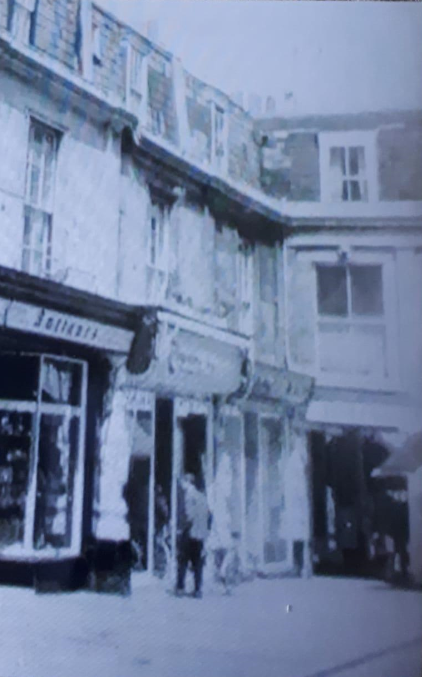
Royden Esq. in the 60s. Image provided by Michael Williams
Royden Esq. in the 60s. Image provided by Michael Williams
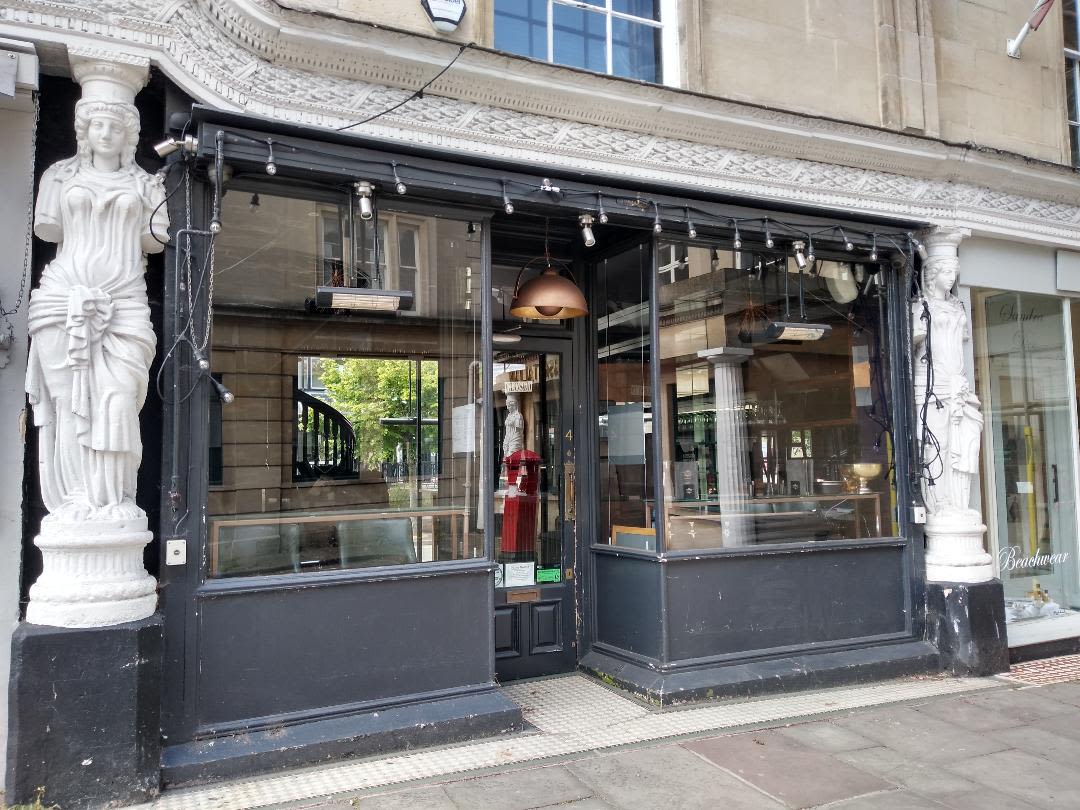
The old site of Royden Esq. in 2020 (now a cocktail bar)
The old site of Royden Esq. in 2020 (now a cocktail bar)
For the times, owners Gil and Roy were progressive in their approach to fashion. They sold all the latest mod gear as well as imported french briefs which they displayed in the window stuffed with tissue paper, much to the entertainment of the local lads.
"He took a lot of stick when he went to work there", Patti said.
It wasn't just the window dressing that drew the attention of the youngsters but the colourful new fashions and flamboyant clothing on sale in the shop.
"Of course he used to get all the lads up there on a Saturday peering through the window and pulling faces and things at the pink shirts" she adds.
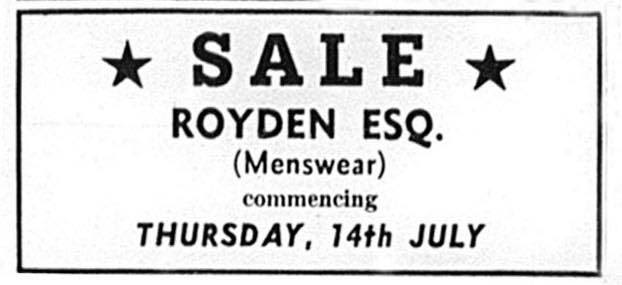
Image: Gloucestershire Echo Archive
Image: Gloucestershire Echo Archive
Patti and Chris would also take trips up to London to buy clothes. The city was the place to tap into new trends and buy the latest mod styles to bring back home.
“It was the exclusivity of it and the fact that it wasn’t easily copied".
At that time, many of the town's young mod population would travel further afield to buy the clothes they desired. Charles Scarrott and Sue Brooks first met 56 years ago on the dancefloor of Cheltenham's local mod club, The Blue Moon.
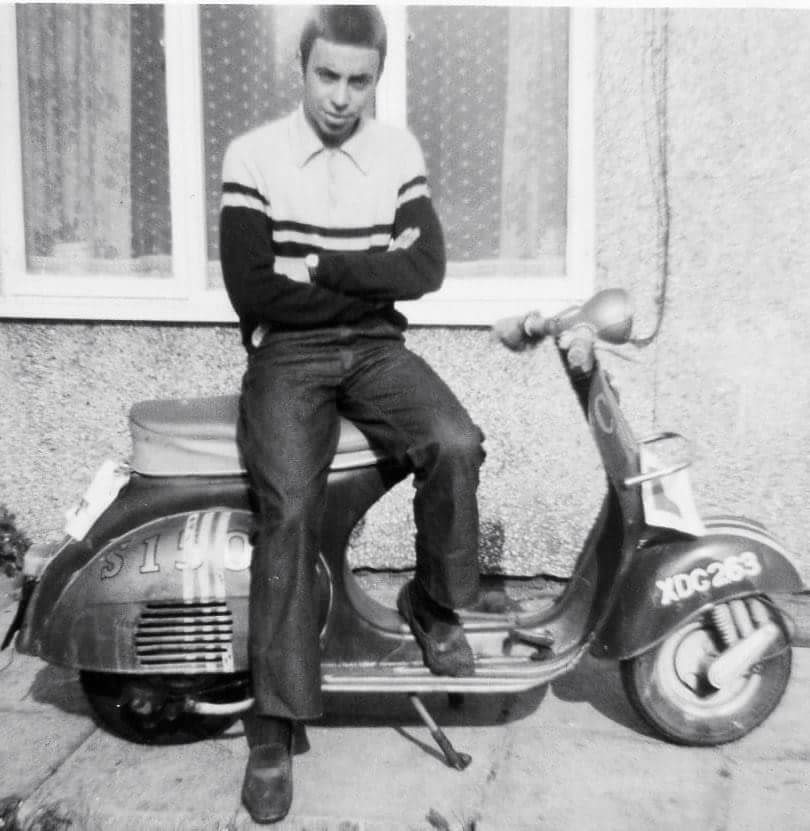
Image provided by Charles Scarrott
Image provided by Charles Scarrott
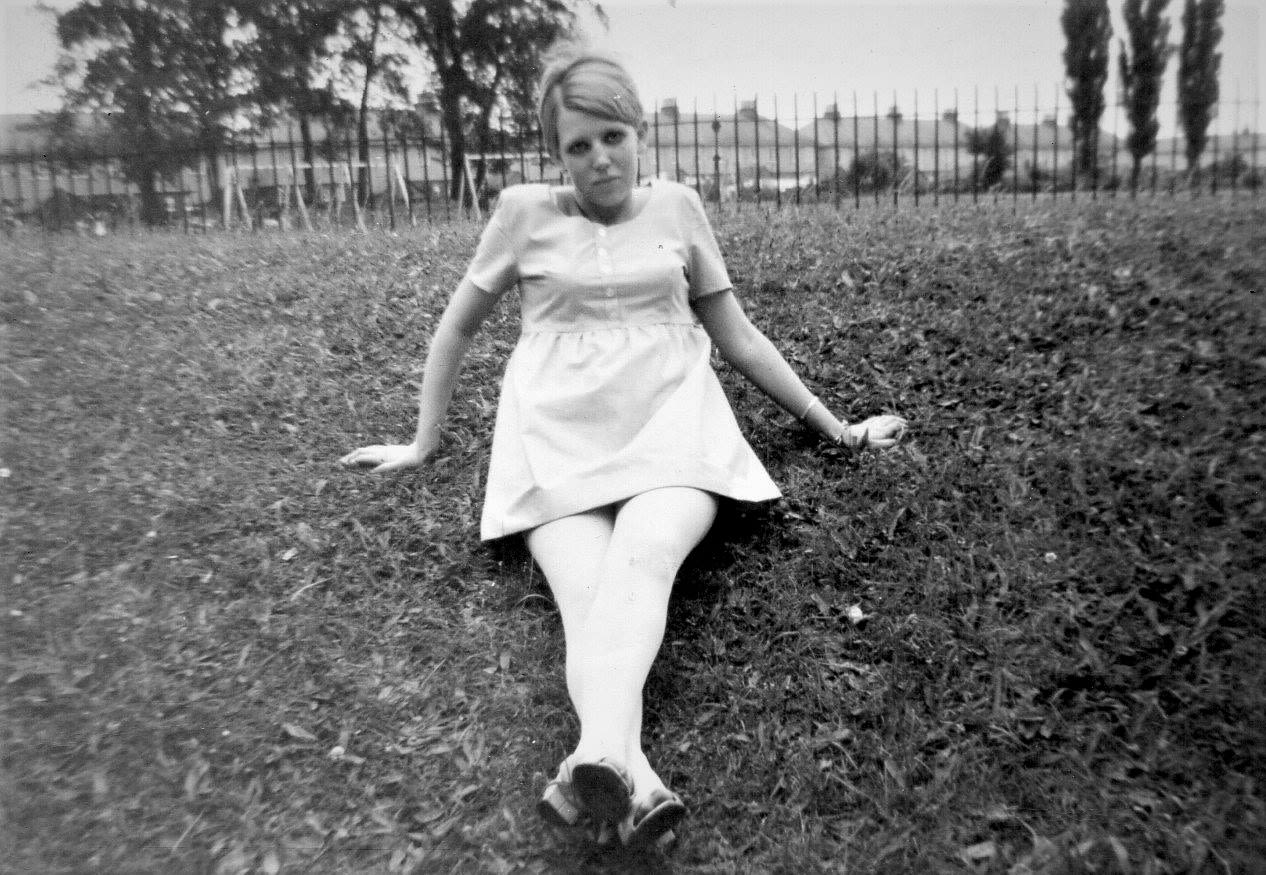
Image provided by Sue Brooks
Image provided by Sue Brooks
“We went to London to get clothes that you couldn’t get in Cheltenham. We went to London to get records that you couldn’t get in Cheltenham” Charles said.
At the bars and clubs, they would be the envy of their friends and unlike today online shopping wasn’t an option.
“You knew that no one else could look like you – you couldn’t go on ebay, you couldn’t go on Amazon”.
Sue would make clothes by getting inspiration from shows like Ready Steady Go and both took a trip to nearby Birmingham to get leather mod coats. Ultimately it was a style that could not be imitated.
“It was the exclusivity of it and the fact that it wasn’t easily copied".
For Charles, it was always more of an attitude of mind that carried the mod fashion and style forward.
"On a Friday or Saturday night when there was a big band on at the moon I’d spend more time getting ready than Liz Taylor!” he laughs.
But the mainstream reproductions and increasing popularity marked the end for some of the more fashion-conscious mods.
"So it was only when it became popular, and everybody started to wear it that it became less fashionable", he said.
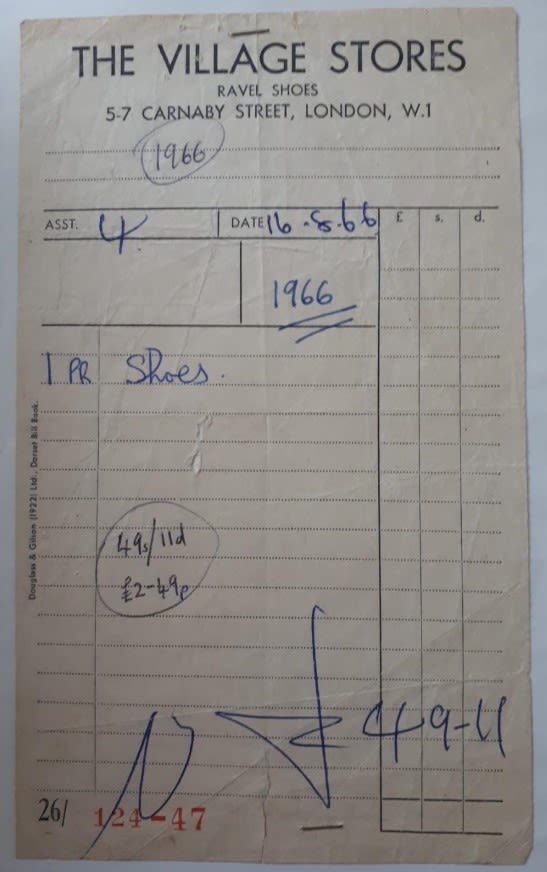
Image courtesy of Michael Williams
Image courtesy of Michael Williams
In his book 'Mods. A Way of Life' Patrick Potter writes that "Men's fashion was now a thing" One person who spotted the business potential of this was a Glaswegian welder, called John Stephen. Stephen was into pop music and opened a small Carnaby Street boutique selling ready to wear mod gear and offering flexible payment options. He opened 15 shops by 1967, which made him a millionaire and earned him the title King of Carnaby Street.
“At the height of my mod dom it was suit, collar and tie – that was it, end of”
At weekends if it was during the day, Charles would wear Levi’s, a Ben Sherman button-down, and a pair of brown loafers, but other than that you had to be smart.
“At the height of my mod dom, it was suit, collar, and tie – that was it, end of”.
Charles would visit local tailor, Douglas 'Dougie' Graham for made-to-measure suits; suits that were clearly made with close attention to detail.
“I went to London and I looked at what guys suits were like; a ticket pocket, a slanted side pocket, double vents, flat bottom, 17-inch bottom, double pleated and I looked and I studied and I’d tell Dougie want I wanted and he made them”.
London was the place to see the different styles but one suit epitomised the sixties mod era.
“We used to love mohair suits. Tonik mohair suits. They looked like Italian suits, black, blue, that sort of shiny shimmery fabric of mohair and when you put it on you felt like you were king of the world. I’m telling you, it was very intoxicating”.
The Mod Girl of the Sixties
Much is always made of the male mod mindset from the sixties. The image of the young working-class man - the confident male "peacock" striding purposefully about, preoccupied with fashion and every last detail of his appearance. His was an image that didn't conform to previously held notions of masculinity and how a young man should look and typified the early mod era.
Ready Steady Girls - The Other Half of the Mod Equation is a book that aims to redress the balance by focusing on mod style through female eyes from the sixties until now. Street Style Blog Subba Culture explores the female perspective further in its review of the book.
"For all the previous focus on mod males the actual shift in attitudes and possibilities the original mod era suggested may actually be viewed as being more radical from a female perspective. Whilst the mod male may have braved catcalls and wolf whistles for donning a pink shirt or a low cut, tight fitting trouser the cultural shifts for their female counterparts stepping forward into a new decade were surely set against a wider, decade solid range set of society and parental held conventions".
In essence, it was a time that gave women the freedom to express themselves and was accompanied by savvy sewing skills.
"Elsewhere ‘tradition’, courtesy of previously learned skills on a sewing machine served the ‘other side of the mod equation’ well and enabled legions of mod girls to embrace one of the key ideas of mod, the presentation of a unique, personal look, a look unavailable to others due to it being a personal creation."
This is confirmed by Patti who made her own clothes and customised old garments into new and exclusive looks many times.
"Chris always said he’d never seen anyone like me because I made my own clothes so I didn’t look like anybody else. People used to say “Oh God, you know, you’re brave wearing that, but I never felt brave I just thought this is how I want to dress and I was quite uncompromising".
In his book, Potter says that the sixties was a time when making your own clothes and recycling old into new was almost a way of life.
"There was easily as much attention to detail in her look as the boys. She was more likely to buy fabric and sew for herself than get dresses made. In the early 1960s, home sewing was almost universal for women".
Being a size eight, Patti struggled to find clothes to fit and was swamped by the range of sizes that only started at a 10 to12. She soon resolved the situation by stitching together her own one-off creations and even knitted herself a pair of stockings.
"I mean imagine doing something like that now, you just wouldn’t would you?" she said.
Patti's creative flair didn't stop there and she even saw re-fashioning potential in the most unlikely of places.
"I adapted my school uniform when I left school. We had these horrible summer dresses, pale blue but they had big skirts so I can remember removing the bodice from the skirt, dying the material and I made this skirt was a sort of aubergine colour, I bought some crocheted lace which I stitched on the bottom and that went with the cream stockings that I knitted. Really cool you know, really cool that was".
Patti's resourcefulness gave her a unique style as well as something new to wear at the weekend. It also saved her money.
"I utilised the uniform rather than just binning it and school shirts, the white school shirts. I bought buttons that were a bit like glace cherries for one of them which made that wearable. But you know we didn’t have any money then. People earned like three quid a week".
In 1965 High street chain Chelsea Girl arrived and once the independent Ragdoll opened its doors in Cheltenham the mod girls had much more choice with ready-made fashion to go.
"Chelsea girl opened which was marvellous because you could buy a skirt and a top for a fiver but that was still more than a week’s wages for a lot of people. I can remember having rather a nice shirt from Ragdoll it was pink satin with off white lace and pearl buttons so that was, you know, quite an expensive item".
Now in her seventies, Patti still possesses that innate sense of style from her mod days that people still compliment her on today.
"There is a bit of a look isn’t there for 70 somethings? I know I’m that age but I don’t think 70. I think it’s an attitude to life really".
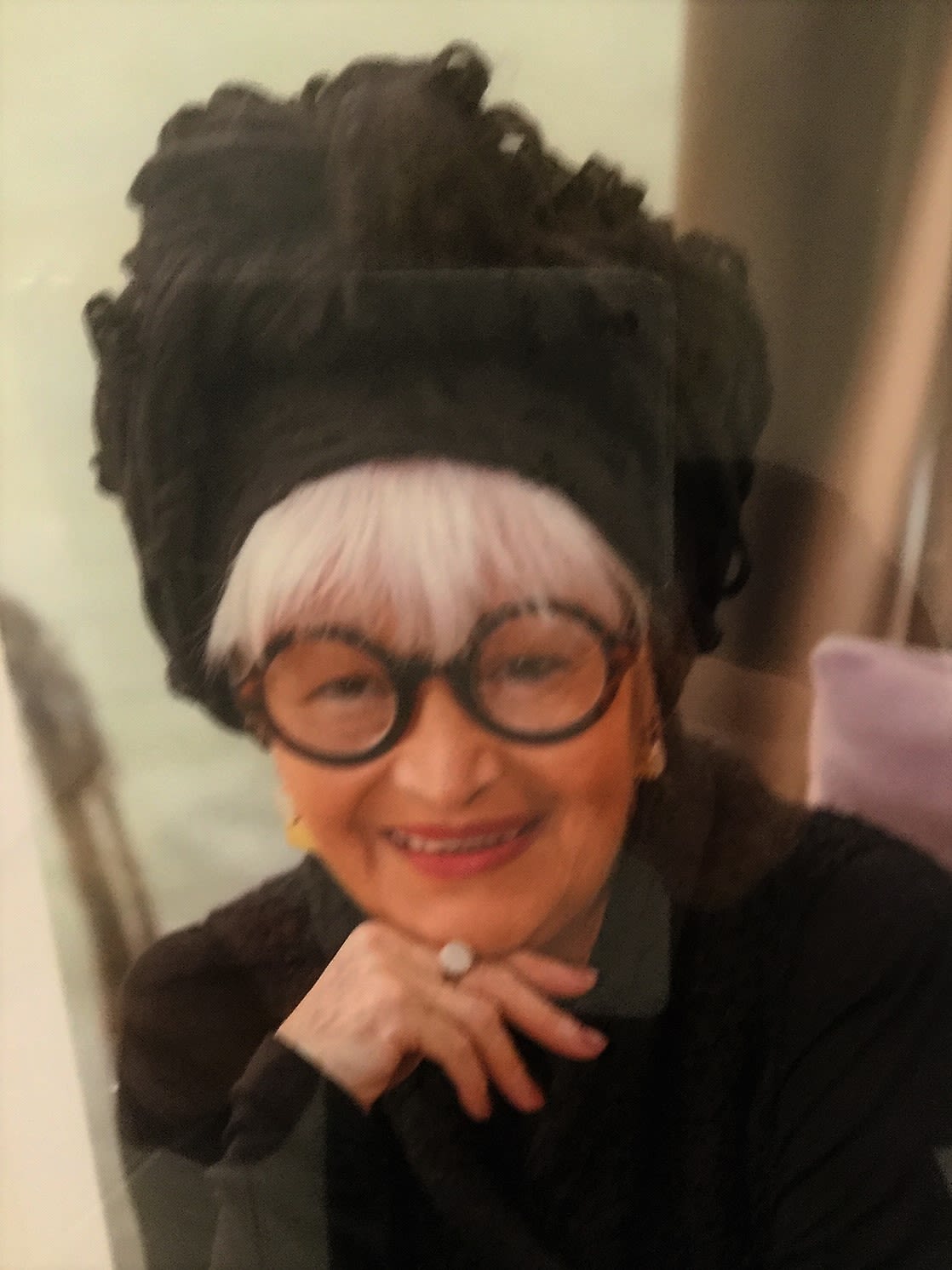
Image courtesy of Patti Garland
Image courtesy of Patti Garland
Patti and Chris always remembered their days in the Cheltenham mod scene with great love and affection
"Even though Chris didn’t live in Cheltenham he still absolutely loved it. He had an immense fondness for Cheltenham and he felt privileged that he grew up there".
It was the prime time of their lives but, she says it was a phase they drifted away from and soon embraced the flower power vibe in 66 and 67 reflected by bands like the Beatles.
"Sgt. Pepper’s lonely hearts club band was a milestone really in that culture shift from the mods to that more hippie thing. Even though we reminisced we never imagined we wished we could go back. It was a youth culture we were heavily involved in it, we loved it but we moved on".
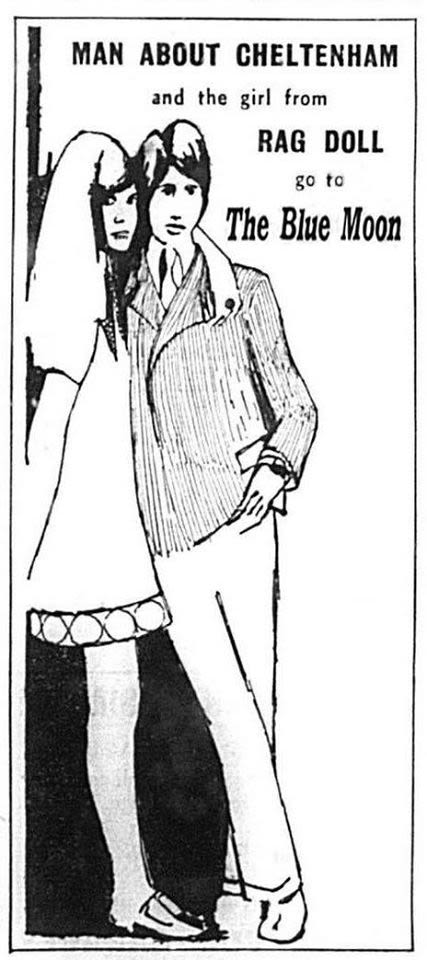
Image: Gloucestershire Echo Archive
Image: Gloucestershire Echo Archive
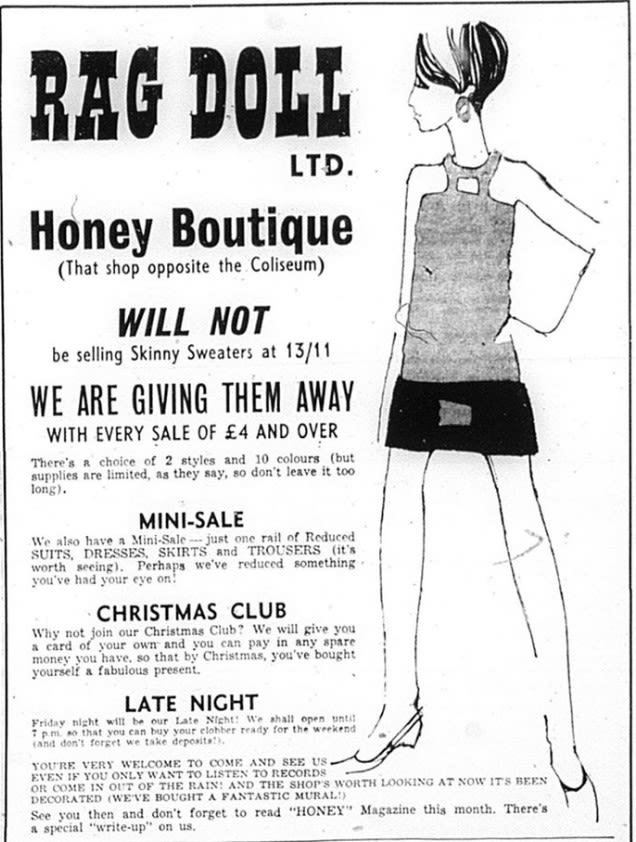
Image: Gloucestershire Echo Archive
Image: Gloucestershire Echo Archive

Image: Gloucestershire Echo Archive
Image: Gloucestershire Echo Archive
The Blue Moon Teen and Twenty Rendezvous
"Being a Blue Mooner,
you can wear that with a badge of honour - it's lucky"
Richard Goddard
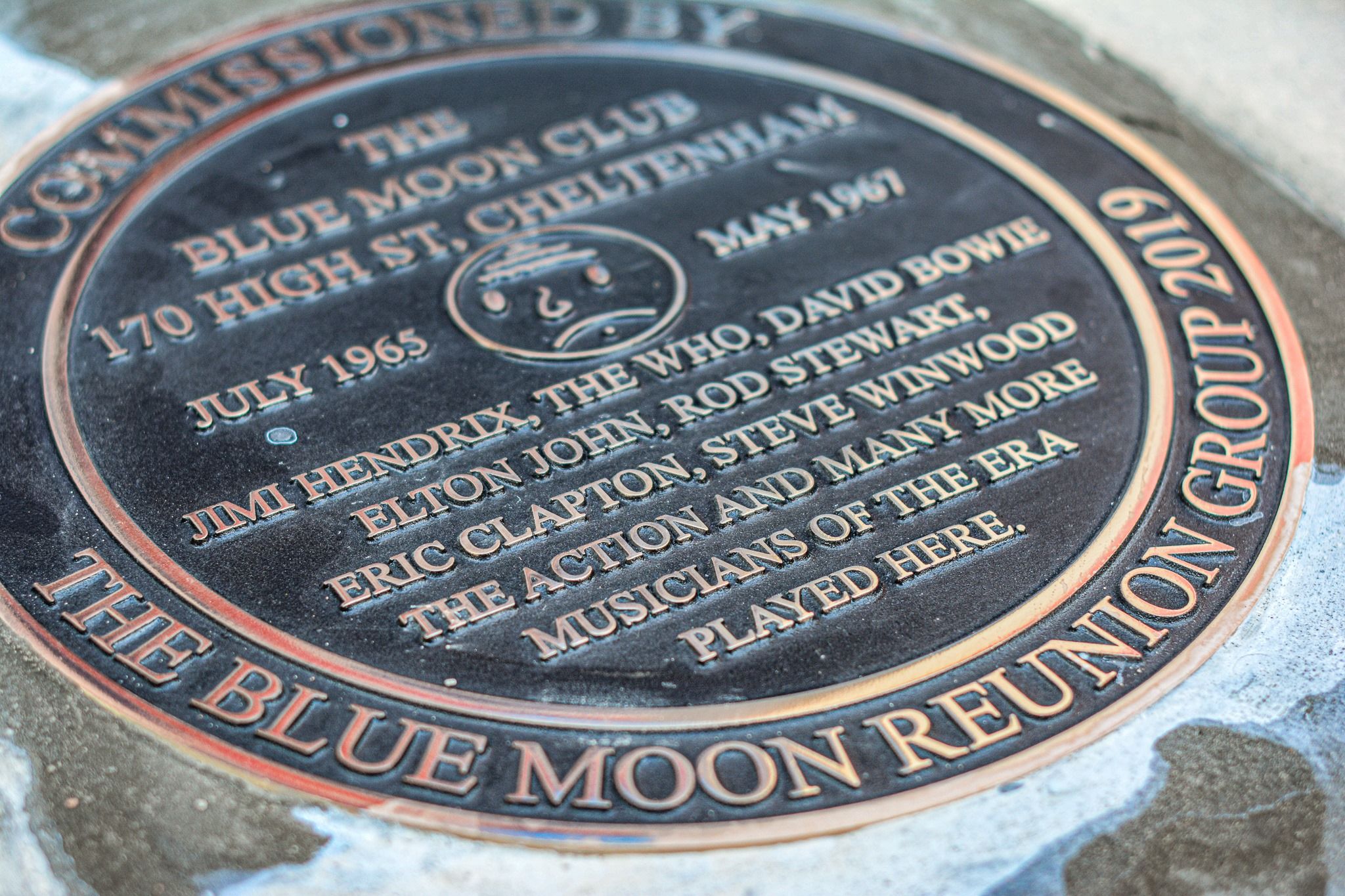
Mod Heaven
The Blue Moon in Cheltenham was open for less than two years between 1965 and 1967. In that time the high street club played host to many artists who would one day become some of the world's biggest musical names of the decade and beyond. The Who, Small Faces, Elton John, and David Bowie all topped the bill. This year marks 50 years since the death of guitar legend Jimi Hendrix who also performed at the club in February 1967.
The club started life in 1965 after London based duo Bill Reid and Eddie Norman decided to open a music venue in Cheltenham. Eddie already ran a club of the same name in Hayes, Middlesex with his brother John and jazz musician Bill Reid promoted concerts at the British Legion Club in South Harrow.
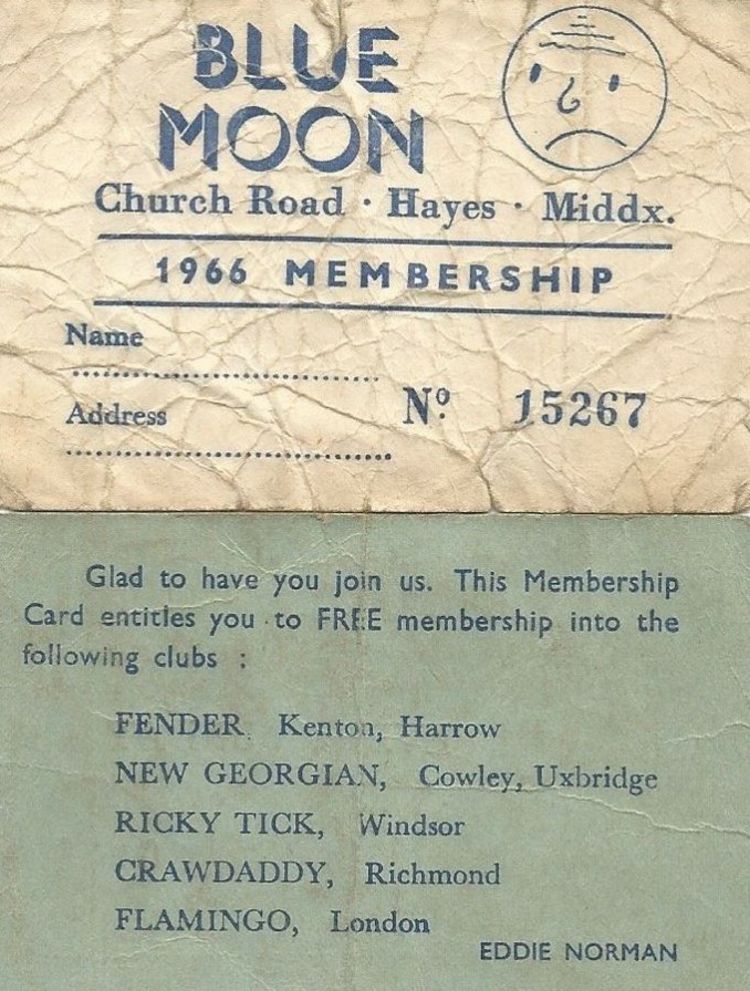
Image courtesy of The Blue Moon Cheltenham.Teen & Twenty Rendezvous Facebook group
Image courtesy of The Blue Moon Cheltenham.Teen & Twenty Rendezvous Facebook group
After seeing an advert in the Melody Maker for a disused dance hall the pair decided to move their music ventures to the South West and the Blue Moon in Cheltenham was born. The pair set their sights on buying the place because of the entertainment license that came with the sale, although for the two years they were open there was no license to serve alcohol.
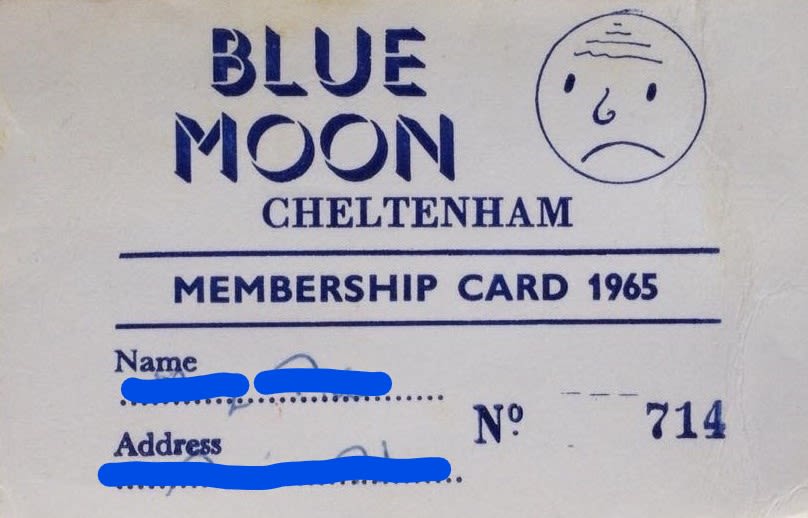
Image courtesy of The Blue Moon Cheltenham.Teen & Twenty Rendezvous Facebook group
Image courtesy of The Blue Moon Cheltenham.Teen & Twenty Rendezvous Facebook group
The club’s location was at the top of a two-storey building above Burtons Tailors and The Savoy Billiard Club run by Percy Bates. The young mods would gather for a game of snooker before heading upstairs.
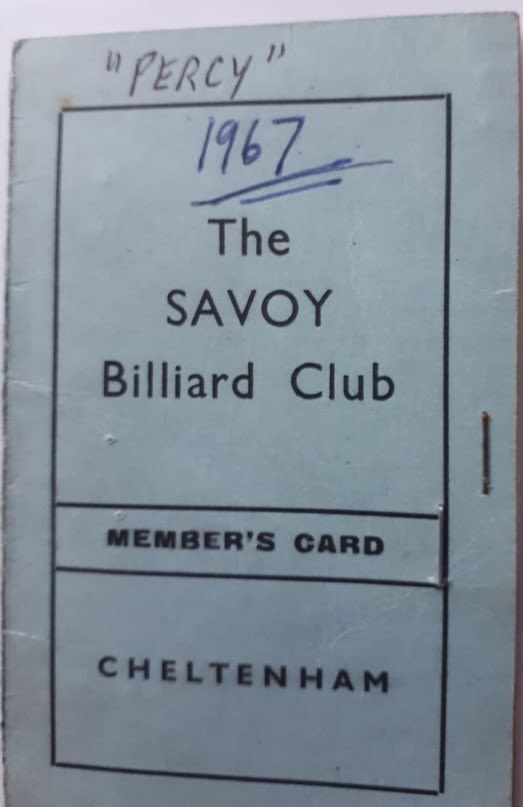
Image courtesy of Michael Williams
Image courtesy of Michael Williams
A trek to the top of the concrete steps was always worth it and held a world of music, dancing, and freedom. Bill Reid and Eddie Norman already had considerable contacts in the industry and were able to book many upcoming musicians and groups who would go on to become global stars of the future.
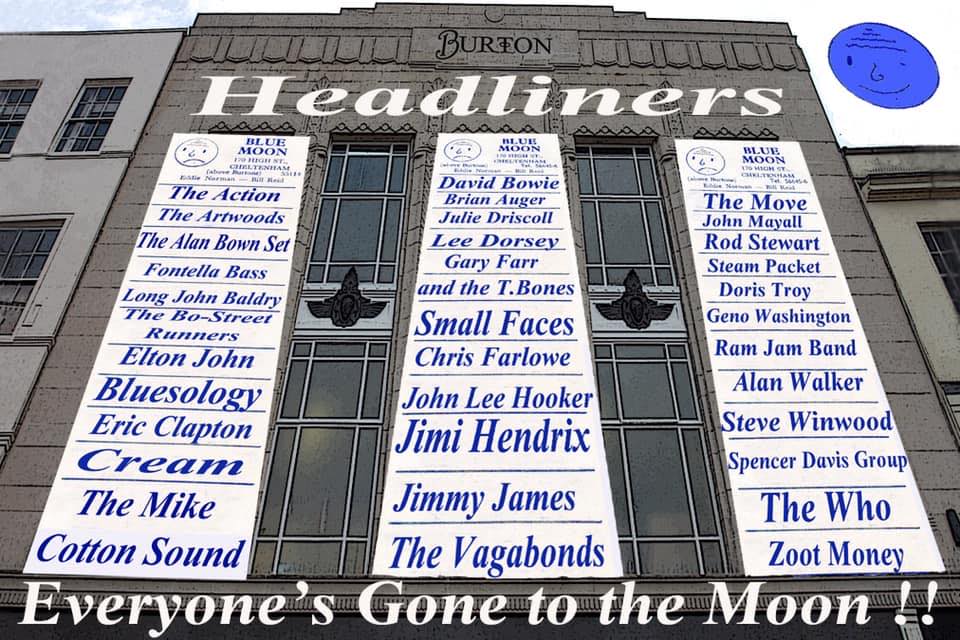
Image provided by The Blue Moon Cheltenham.Teen & Twenty Rendezvous Facebook Group.
Image provided by The Blue Moon Cheltenham.Teen & Twenty Rendezvous Facebook Group.
Michael Williams was a regular at the Blue Moon until it closed in 1967.
“Yes, it was at the top! We’d go to the tailor's shop, Burton’s for our made to measure suits, which usually took two or three weeks to make. Up the stairs we would call into the snooker hall, then an hour or so later go to that now iconic and dimly lit venue for dancing, soul, and Tamla Motown music. The Blue moon was dark and sweaty, condensation ran down the walls as there was no air conditioning, and of course, smoking was allowed then”.
Richard Goddard - Founder of The Blue Moon Cheltenham.Teen & Twenty Rendezvous Facebook Group
Christopher Stanbury - Co-founder of The Blue Moon Cheltenham.Teen & Twenty Rendezvous Facebook group
“Every generation leaves their own mark on history but that Sixties era was an outstanding period of change in the way of life, of politics, exploration with the moon landing and of fashion and in particular of music”.
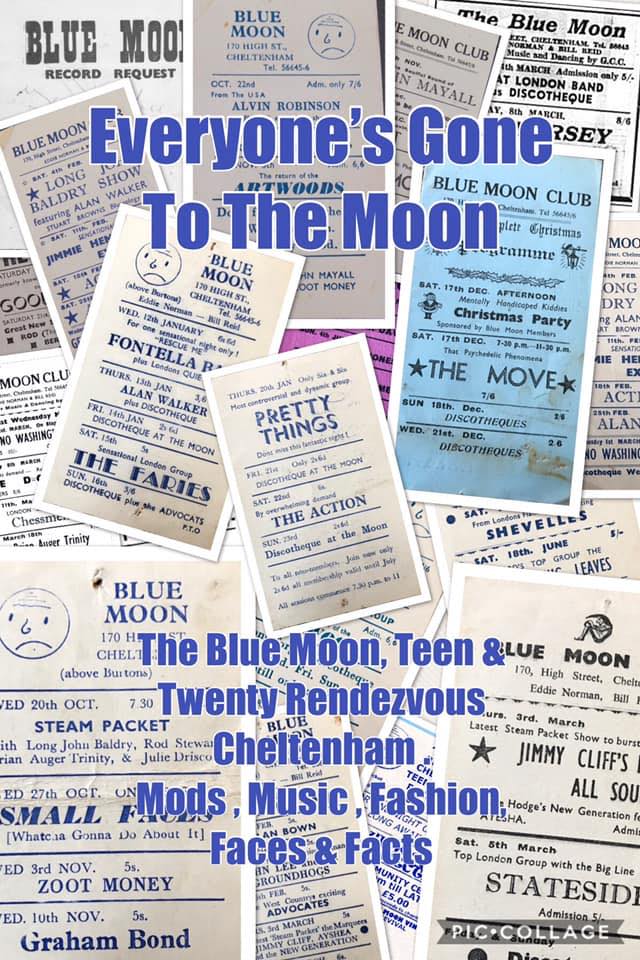
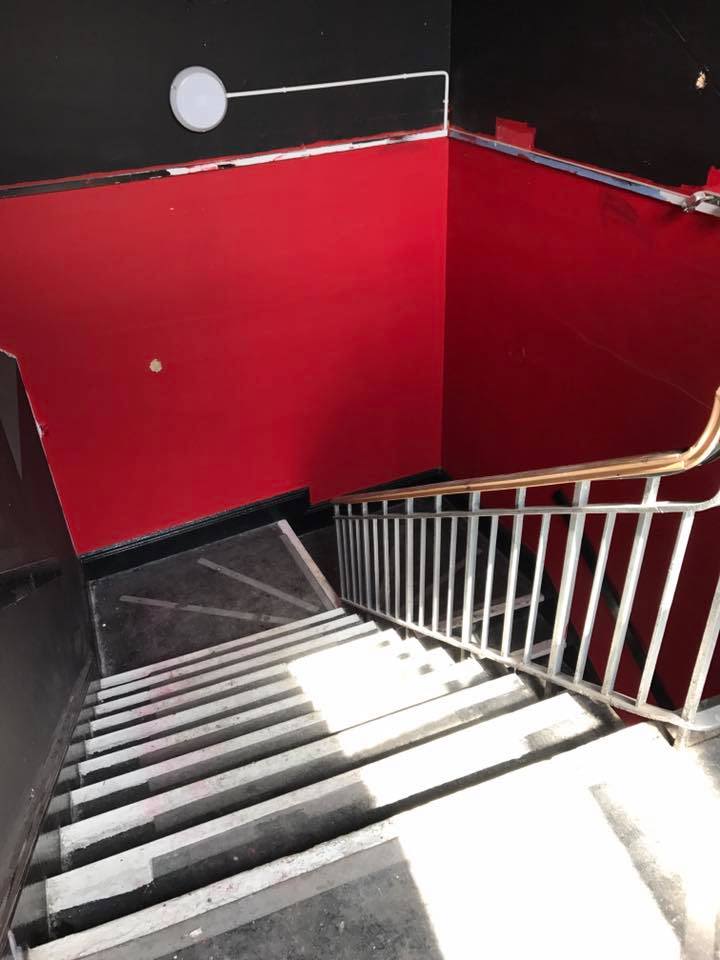
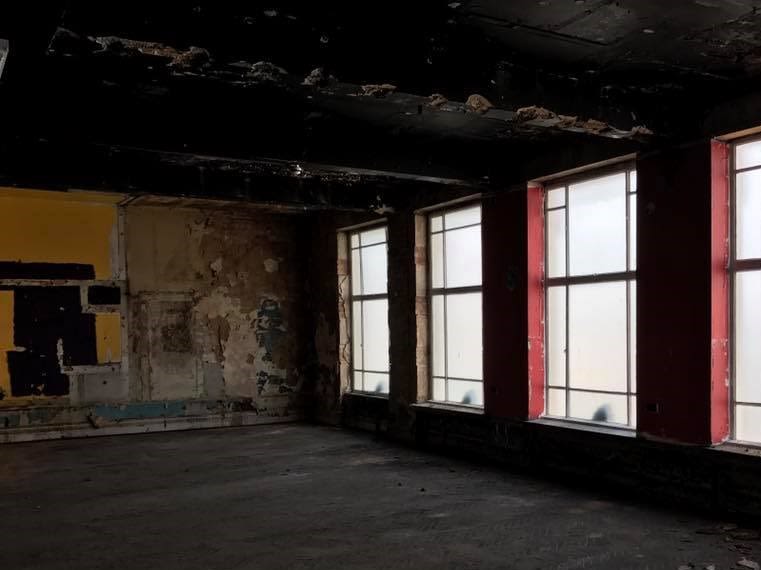
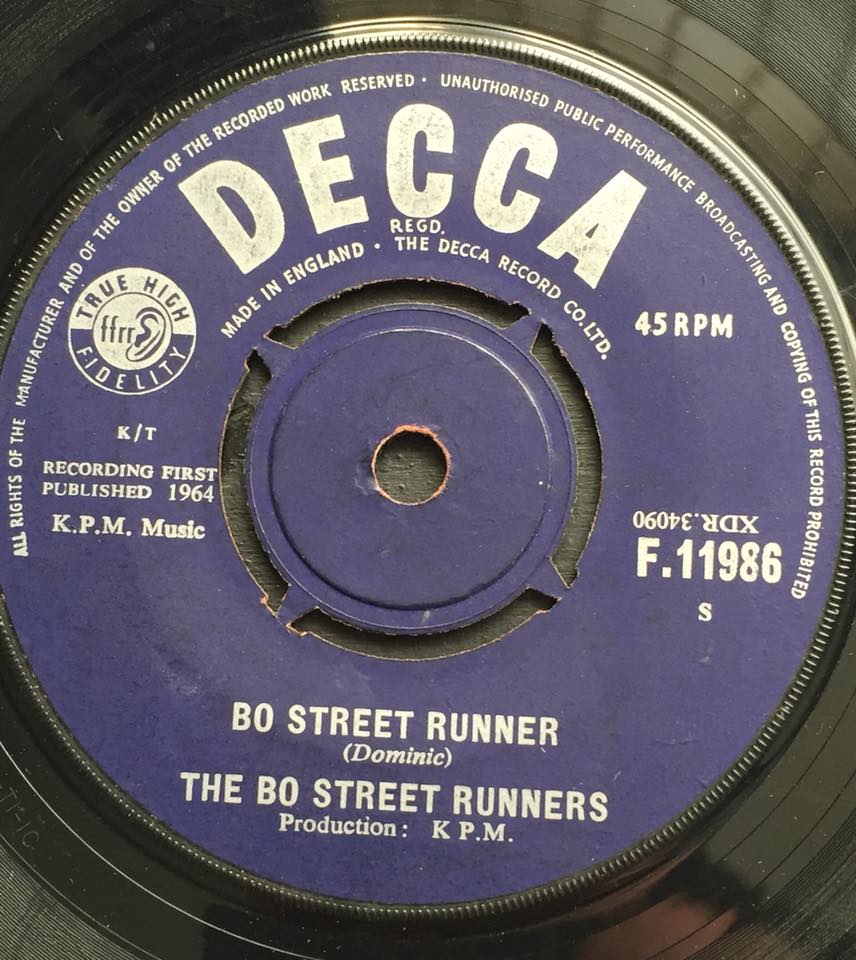
“If I’d had three lives I’d of lived them all in the Blue Moon for those two years I tell you”
A passion for the music meant Charles Scarrott was also a frequent visitor to the club.
“I went five nights out of six; it was probably open four or five nights a week and I went to most of them”.
Sunday nights always featured a disco and Thursday nights were normally reserved for the bigger groups before they headed off to play larger venues on a Friday and Saturday.
"You’ve got to remember," he said, "You didn’t have Alexa and Spotify, if you wanted to listen to music you played the radio or you bought a record".
Although a lot of what was played on the radio was considered a little old fashioned by the young mod's standards.
"If you wanted blues, soul and all the American stuff that we all enjoyed, you went to the Moon and they had these records that the guys would be buying from airbases or buying on imports and all the great songs which are now lifetime classics, the first time I ever heard any of them was in the Blue Moon".
The popularity of some of these songs meant they would be requested "up to six times during the evening" Charles said.
“If I’d had three lives I’d of lived them all in the Blue Moon for those two years I tell you”.
"It was the whole of Mod culture all over the country all encapsulated and condensed into one little club in Cheltenham high street".
But by the time the Blue Moon closed its doors for the final time, mod culture as Charles knew it when it started was coming to an end.
"Because as soon as it got to be mainstream all the people that liked it didn’t want to be associated with it anymore. It was a thing that was perfect for its time, the music, the clubs and the Blue Moon opened at exactly the right time to take advantage of it. It was the whole of mod culture all over the country all encapsulated and condensed into one little club in Cheltenham high street".
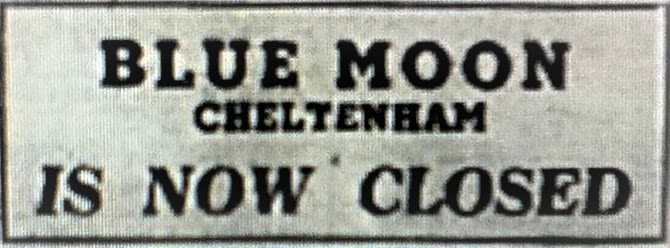
Image: Gloucestershire Echo Archive
Image: Gloucestershire Echo Archive
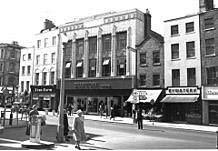
The Blue Moon in Cheltenham High Street. On the top floor above Burton's Tailors. Image courtesy of The Blue Moon Cheltenham.Teen & Twenty Rendezvous Facebook group
The Blue Moon in Cheltenham High Street. On the top floor above Burton's Tailors. Image courtesy of The Blue Moon Cheltenham.Teen & Twenty Rendezvous Facebook group
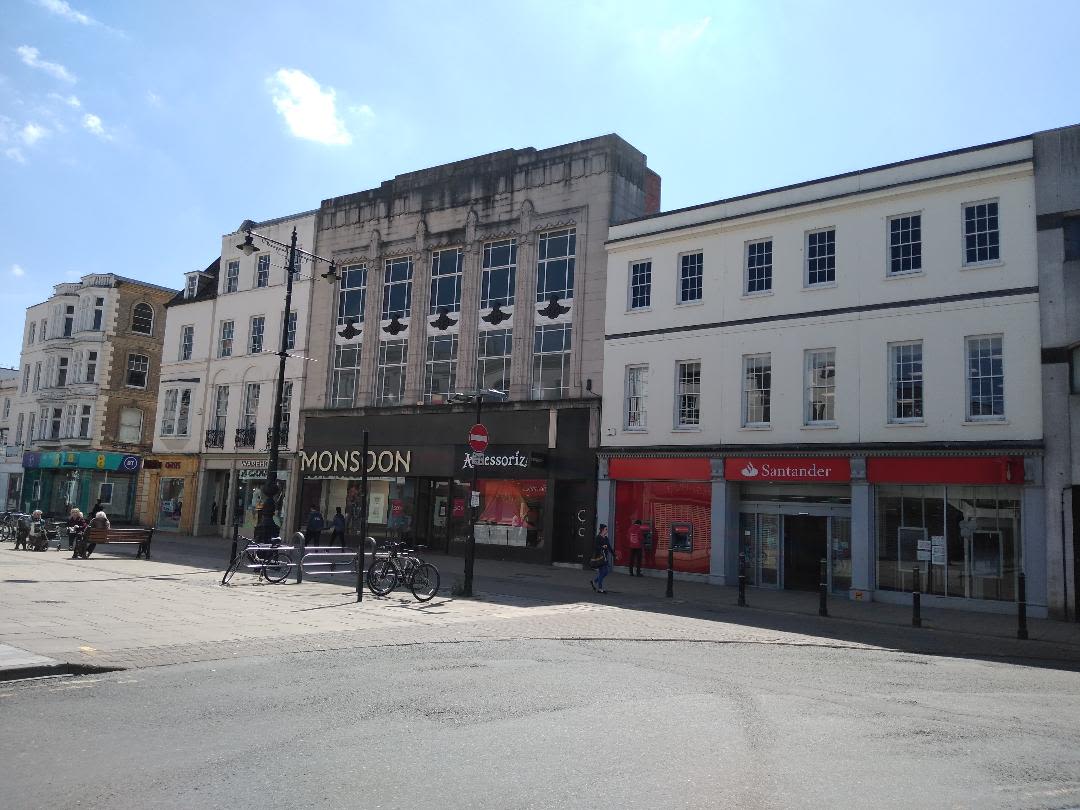
The Blue Moon site today above Monsoon.
The Blue Moon site today above Monsoon.
A Defining Moment
"Britain's most enduring sub culture"
Mod revivals have been around since the birth of the youth subculture in the 1960s. The 1979 mod classic Quadrophenia is now over 40 years old and two new feature films based around mod culture have been released this year. 'The Pebble and the Boy' is directed by Chris Green and inspired by the music of Paul Weller and 'To Be Someone' is a film by Pete Meadows and Ray Burdis. Mod revivals keep coming back and with three generations of mods, it's fair to say they never really leave us. So what is it about the subculture that still endures to this day and why is it still relevant?
Claire Mahoney is a journalist, editor, broadcaster and author of Welsh Mod a book documenting the roots and revival of the Mod subculture in Wales over more than 50 years. She has regularly appeared on BBC Radio Wales to talk about The Jam, Paul Weller, Mod and sixties soul music and is launching a printed magazine about the mod scene called Detail.
Mahoney got her introduction to the mod scene through the 80s revival and has been part of it for most of her life in some form or another. For the last decade, she has been writing in her spare time for sites like Modculture and interviewing various musicians.
The idea for a book about the Welsh scene came about after many visits to London; a concept that was based on a feeling that the Welsh story had never really been told.
"I had this idea that I wanted it to be a visual story. It was very much about having first-person stories and memories like a piece of social history really”.
The notion that mod has always been viewed as a London based way of life is a perception that Mahoney set out to change.
"I like the idea that you get really smart mods in the Welsh valleys that are dressed to the nines riding around on Lambrettas in places where you really wouldn’t expect to see that”.
“Also the fact that it’s very easy to be into style when you live in London. I’ve lived up in London and you can wear what you want there but when you’re growing up in a small-town environment, you’re going to stand out like a sore thumb really. So I think I like the idea that it was this subculture in the truest sense of the word that it was the antithesis of what you really expect of a Welsh Valleys person".
"It’s a defining moment but at the time you don’t realise it"
"When I was interviewing people from the first generation of mods, people in their seventies, it was such a defining moment for them. The music that you get into when you’re a teenager kind of defines the rest of your life, but you don’t really realise it at the time. So the people that I spoke to from the 60s that has stayed with then for the rest of their lives for 50 or 60 years and the people that got into the revival period in 79 or prior to that, it stayed with them so that’s my kind of my generation now".
"At the time your choices were really that or Duran Duran and Culture Club and it didn’t really do it for me"
Her own experience started at around age13 listening to her uncle's sixties records from the jukeboxes he used to stack. Influenced by the music of Otis Redding and Motown among others, her best friend’s brother also owned a scooter. This and the other mods that were around kick-started her own passion for the subculture.
“I heard Secret Affair which was a revival band and I really loved them and I got into the Jam. I was listening to sixties music. At the time your choices were really that or Duran Duran and Culture Club and it didn’t really do it for me. I really liked the image. I liked the politics of the Jam as well because obviously, it was Thatcher’s Britain. It was a very different time and it gave me some sort of identity and a sense of belonging as you’re going through those teenage years”.
"The Mod revival was really a tribe in it's own right and for many people it provided an escape from the horrors of the1980s"
"I think that’s quite true of sub-cultures. If you meet old punks, old skinheads, you know we had all our tribes at that time and prior to that you know hippies, rockers".
The cult of the DJ and dance music put paid to that she suggests.
“Music had become much more homogenised and much more commercial. I don’t know whether it was dance music or what really that changed it, but I think it was the whole DJ thing that happened in the late 80s and 90s. Music would just become very computerised and just produced by one person and bands became less relevant in terms of the mass consumption of music. There were no tribes or anything. We had Britpop but that was quite influenced by mod that was like another wave of mod".
"Nothing has endured through decades like mod has"
It's the generational experience down the years, she says, that holds the key to the enduring appeal of the mod style and music.
“You’d get the people that were kids in the sixties listening to the stuff their parents listened to if their parents were mods. Then they kind of got it then in the late seventies when they were teenagers and they referred back to it. What happened then in the Britpop era is that they’re the kids of the generation that were mods in the revival. That’s what it is and I refer to it in my book as Britain’s most enduring subculture. It’s quite unique in that sense. Nothing has endured through decades like mod has".
That's why you can be in your sixties and people can tell you were a mod by just a few items of clothing.
“The elements of mod have always been about style and good taste and I think those things can transcend time”.
Once a Mod always a Mod?
“When you’re a mod you’re a mod all the way, from your first mohair suit till when your hair turns grey”
Jayne Thomas runs the mod subculture and soul music website Soul and Mod A friend in the 1980s made a simple statement that has stayed with her to this day. “Mod is ingrained within you”. She recalls these words as being totally accurate and profound and a truth that many can relate to as the mod scene either was or continues to be a big part of their lives.
Alfredo Marcantonio witnessed the 1964 Bank holiday clashes in Brighton as a young mod. He still believes in style and has a Vespa in his garage. Speaking on BBC Radio Sounds he confirms the answer to this question with a quote from British DJ and early mod Jeff Dexter “When you’re a mod you’re a mod all the way, from your first mohair suit till when your hair turns grey”.
"My hair is grey", Marcantonio says "So I guess I’m guilty as charged”.
“I think it’s kind of a template that you’ll always go back to in some form or another". Mahoney agrees,
"So yes I do think it sets a template for your life musically and style-wise in terms of clothes. It’s something that you’ll always love”.
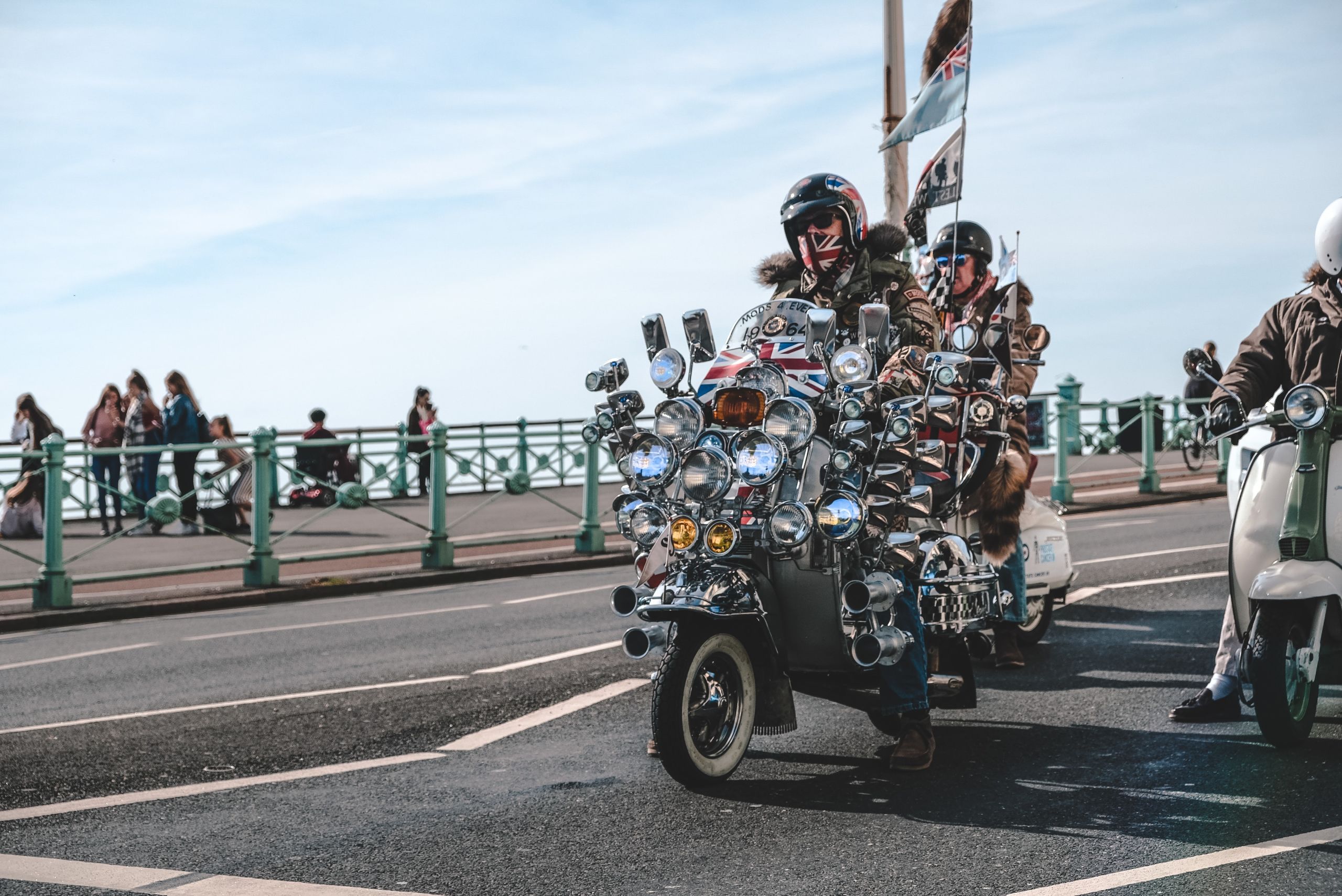
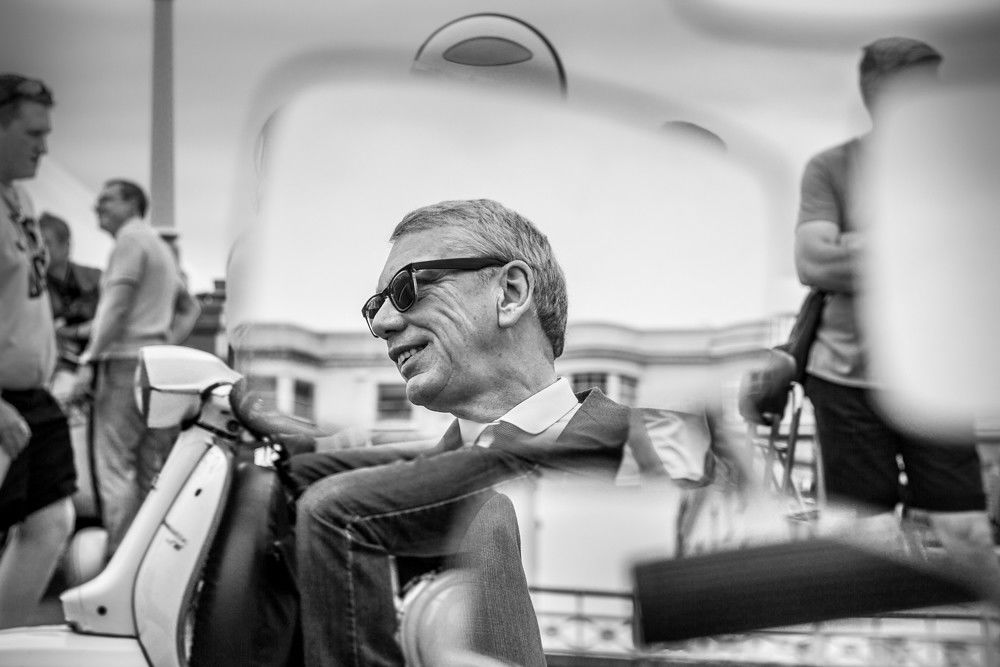
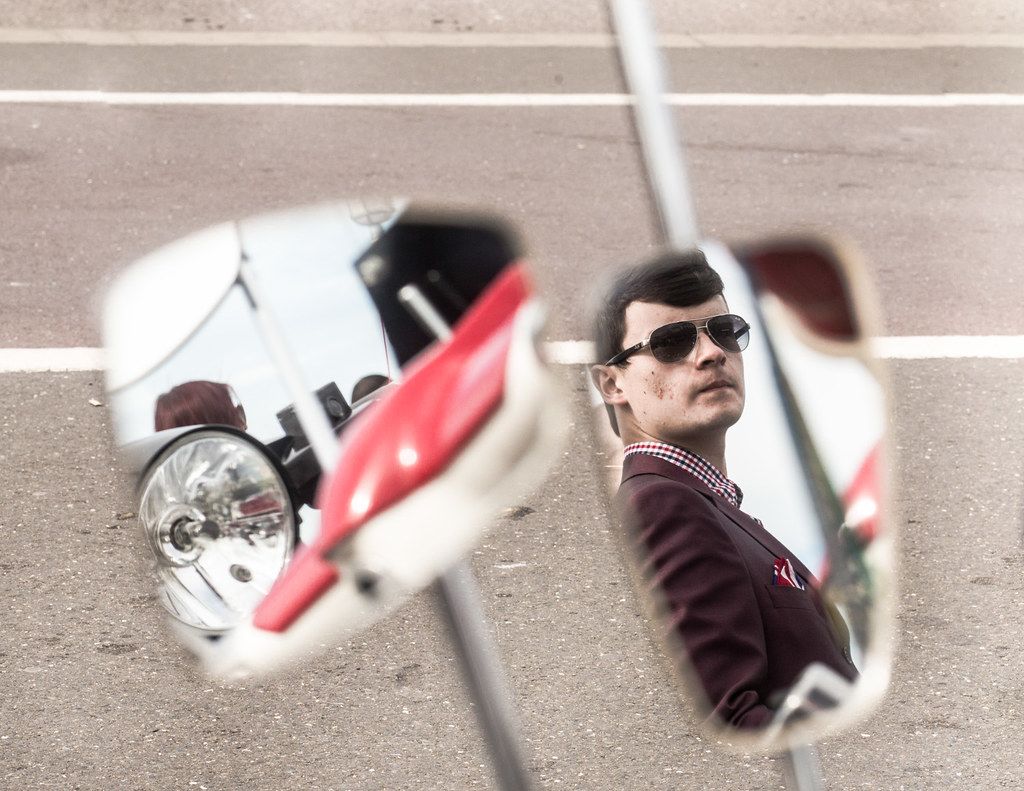
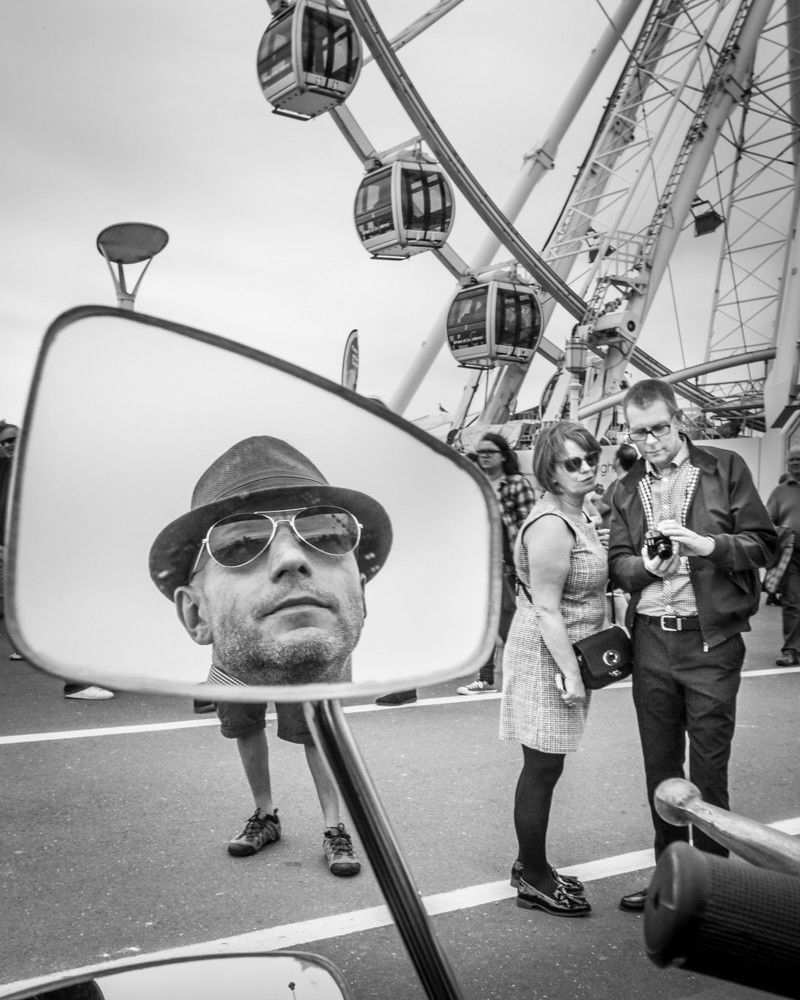
The Brighton Mod Weekender
“Every August bank holiday for the last ten years I’ve either been in Brighton or I’ve been to the Isle of Wight Scooter Rally. The scene is massive, people do not realise but it’s absolutely massive. You could go to a mod night anywhere in the UK every weekend. It’s absolutely huge and it’s for the young generation of mods coming up now in their twenties, and at these events you get people from all three generations".
The Brighton Mod Weekender
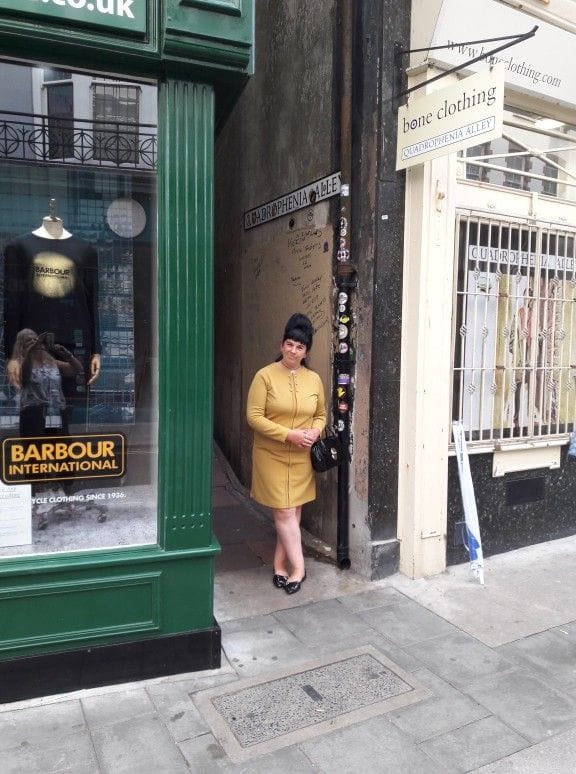
Quadrophenia Alley. Image credit: C.Jones
Quadrophenia Alley. Image credit: C.Jones
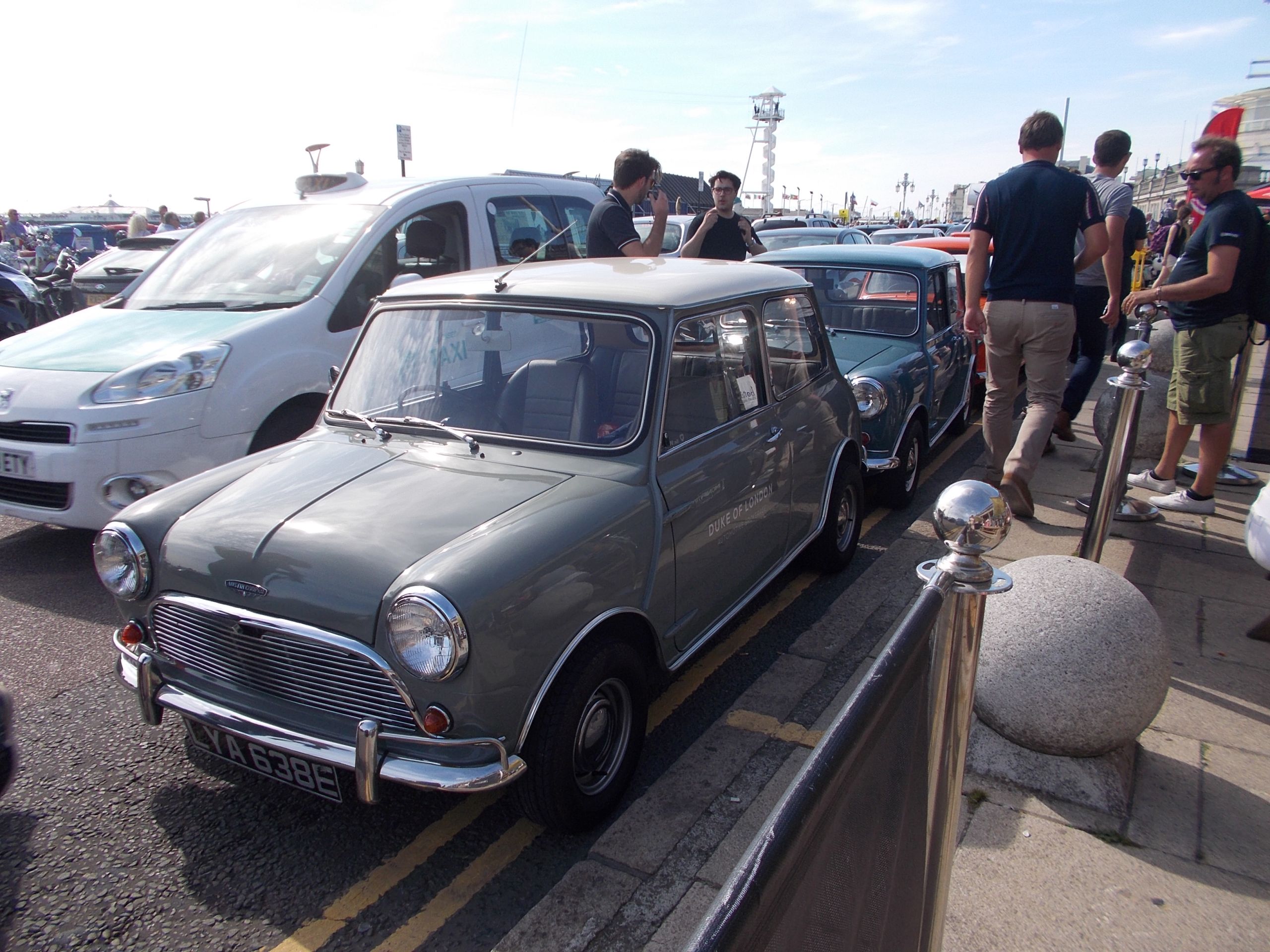
Brighton Mod Weekender. Image credit: C.Jones
Brighton Mod Weekender. Image credit: C.Jones
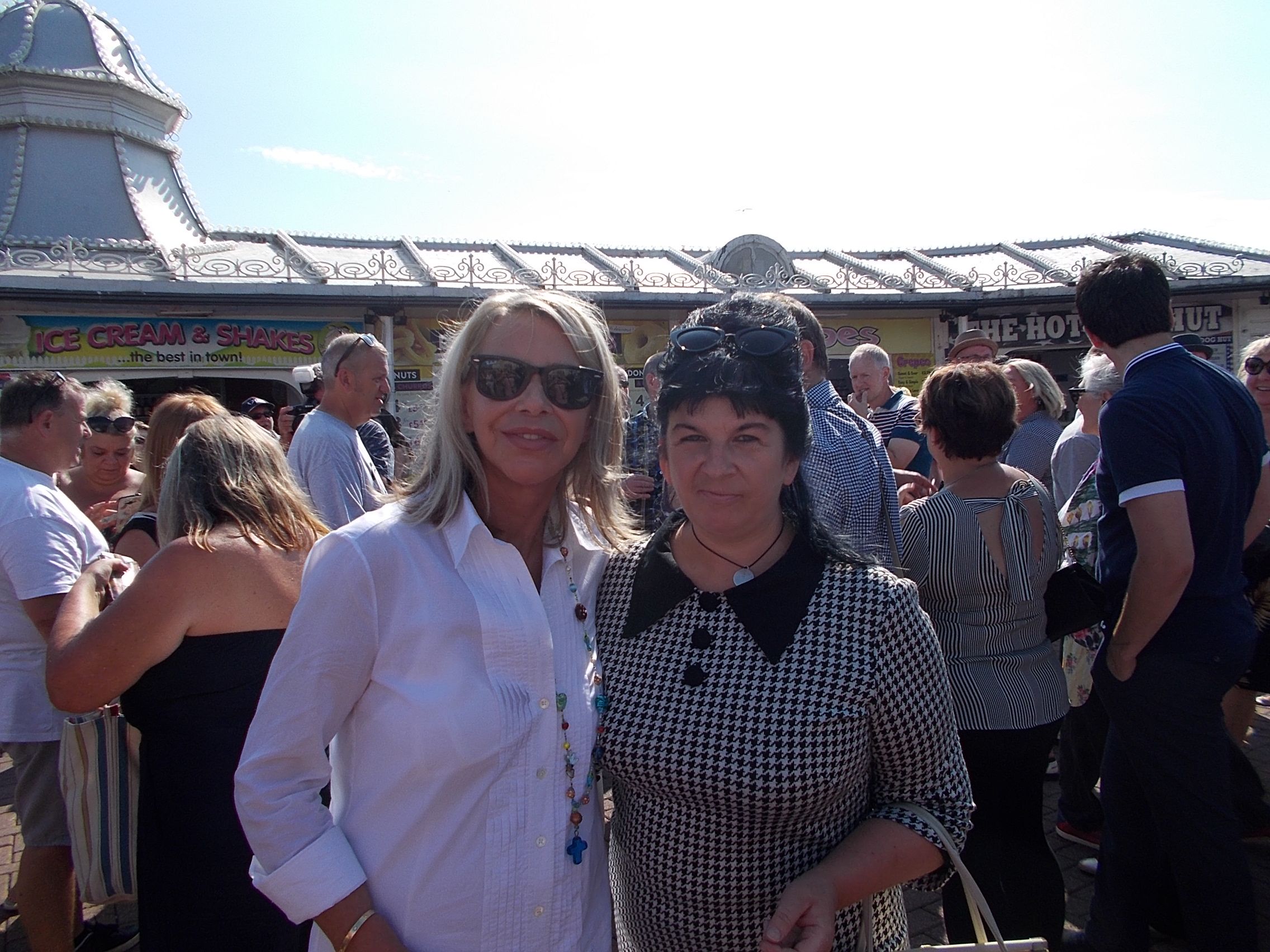
Quadrophenia actress Leslie Ash at the Brighton Mod Weekender. Image credit: C.Jones
Quadrophenia actress Leslie Ash at the Brighton Mod Weekender. Image credit: C.Jones
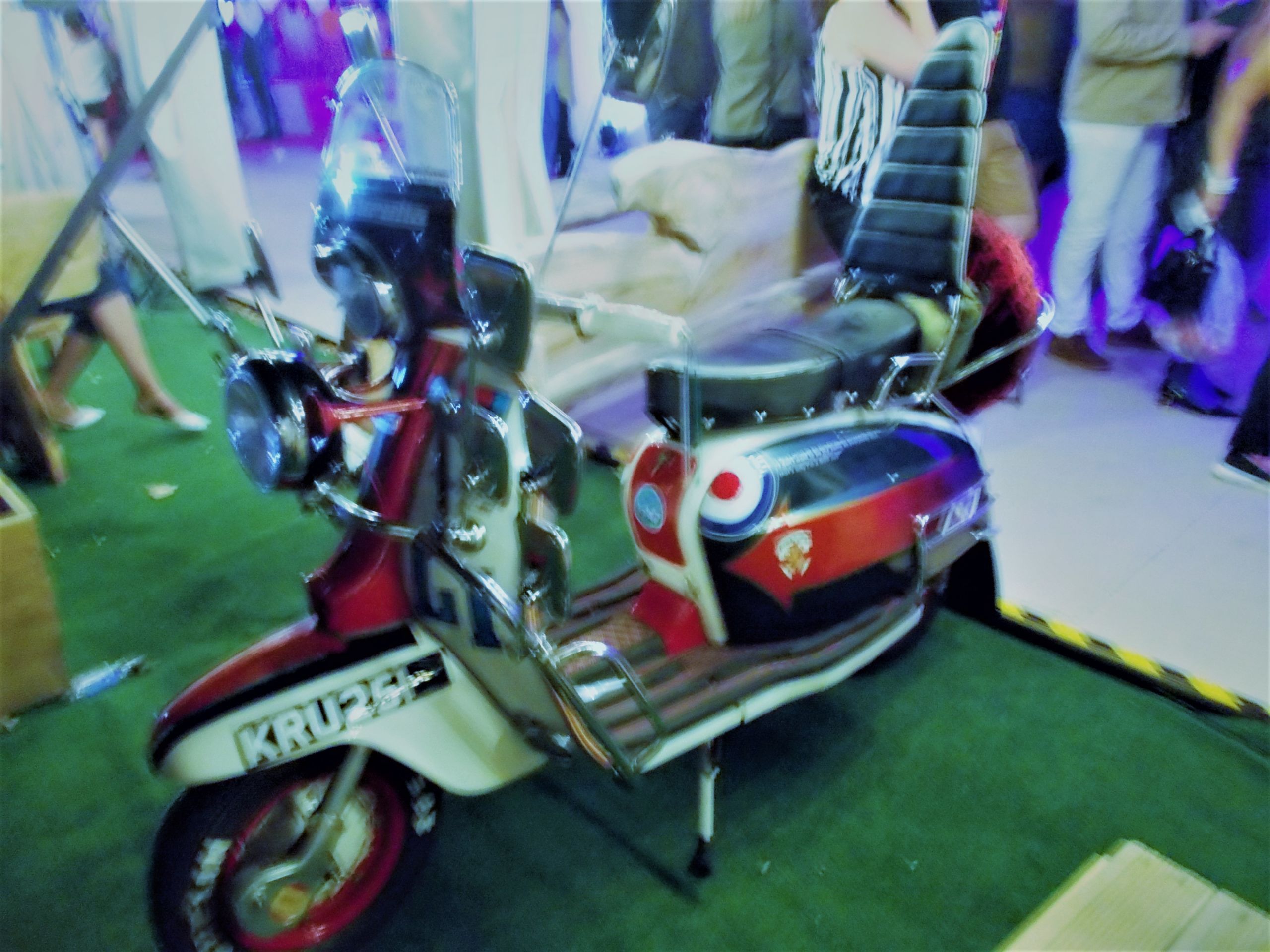
The scooter used in Quadrophenia by Phil Daniels in the role of Jimmy. Image credit: C.Jones
The scooter used in Quadrophenia by Phil Daniels in the role of Jimmy. Image credit: C.Jones
No One Definitive Look
"We picked the best bits and out of the best bits we got mod”.
Mod is a "British thing" and something to be proud of Mahoney says and when it comes to the fashions there is no one definitive look. Mod style has evolved over time from a collection of influences and trends from different eras and places.
“We were like magpies really that took the things that we liked from lots of other different scenes and cultures and then borrowed them and made them our own. We picked the best bits and out of the best bits we got mod”.
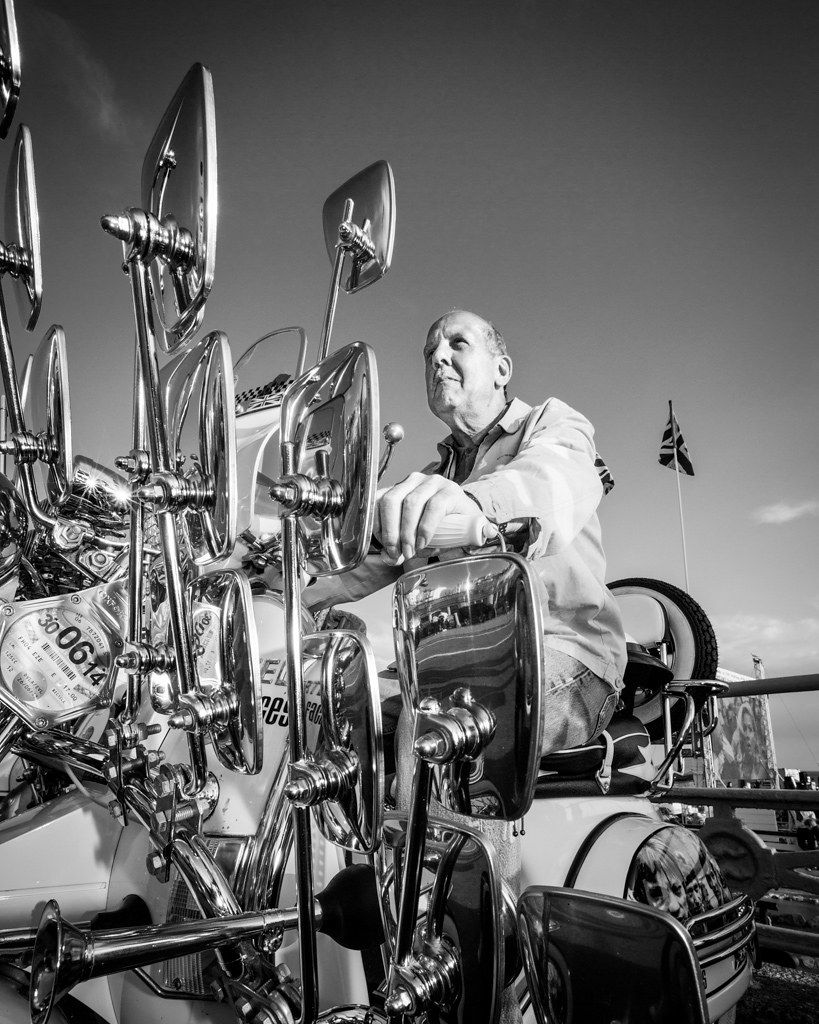
Image credit: Brighton Mod Weekender 2013 Heather Buckley Flickr
Image credit: Brighton Mod Weekender 2013 Heather Buckley Flickr
“I think it’s probably too broad to call it definitive but you’d know it if you saw it. I do think it’s quite classic and simple but I think beyond that it’s quite difficult to describe really. Saying that there’s a definitive way of dressing would make it sound like there’s a uniform and I don’t think there is a uniform”. I think it’s just a bit of a melting pot of influences from American and continental styling”.
Music of the 80s Revival
The first major mod revival band Mahoney says were Secret Affair, "The Jam forged their own path although they were seen as the mod band”.
Other bands like The Merton Parkas, The Purple Hearts and The Chords also emerged in the revival but the music press didn't make it easy for them. At that time the NME and the Melody Maker really hated mods, she points out. It had all become too commonplace and seemed like every new band was jumping on the mod bandwagon.
Musically the sound was different as many of them borrowed from Punk and bands like The Buzzcocks “If you listen to a band like The Chords they sound very much like the Buzzcocks” she says.
They also lacked the style of their sixties predecessors.
“The mod revival bands were very influenced by punk and very very different from the original 60s mods in the way that they dressed. It was much more kind of garish and brightly coloured with boating blazers”. It wasn’t very style-conscious compared to the sixties. It was more related to punk".
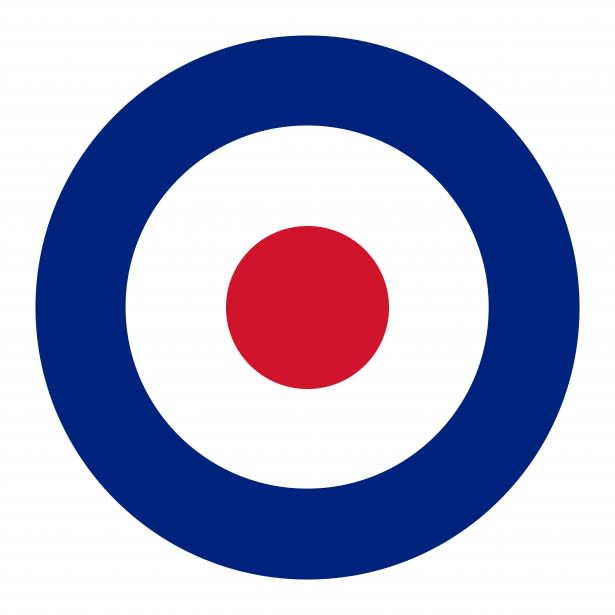
Image credit: Commons.wikimedia
Image credit: Commons.wikimedia
The parka with targets and badges so closely associated with mod style is actually the influence of that sub-culture."Those are all bits and bobs that were borrowed from punk really". she says.
Another fundamental aspect of the mod revival was the emergence of Two-Tone, Mahoney says."The rude boy/rude girl scene was also a really big part of the mod scene". Bands like Madness, The Specials, and The Selector were all absolutely huge.
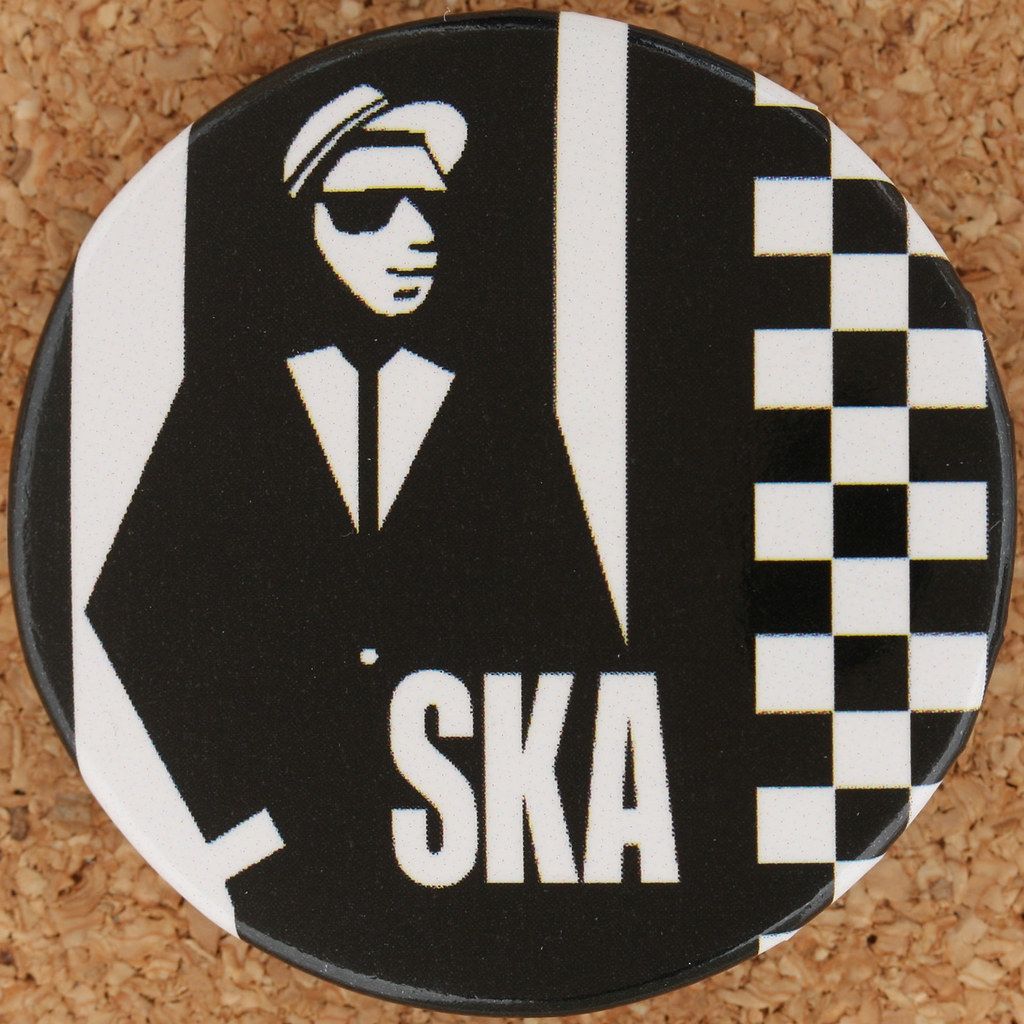
Image credit: Leo Reynolds. Flickr
Image credit: Leo Reynolds. Flickr
“It all fell under the mod revival umbrella. That was a nod to the fact that obviously mods traditionally listened to American black soul music and R&B music but not R&B as we know it today. R&B as it was then. That was the music we listened to. Bands like the Specials were influenced by soul and reggae and music that original mods would have listened to in clubs”.
It was also an answer to society's wider social ills and to the prevalence of racism and violence during that period.
“Obviously black and white musicians were playing together hence the whole idea of the Two-Tone label. So that kind of style of music was a really important part of the mod revivals and also a reaction to what was going on in society at the time. There were lots of race riots and the strong national front element that was in the skinheads”.
Preserving Memories
Mod subculture has been documented on a national level many times and regionally there have been recent exhibitions about the Dungeon club in Nottingham which was open from 1964 to 1968 and 'Punks on scooters' is a book all about the Bristol revival scene. The Welsh Mod story is really a local story too and as Mahoney says this is because “The story of mod has always been very London centric so it’s kind of more interesting to look at it in the provinces as they call it”.
The Blue Moon in Cheltenham is undoubtedly a huge part of the town’s cultural history. A commemorative plaque was laid in front of the old entrance in August 2019; a big highlight after a long wait for the reunion group. The unveiling was attended by old members and Steve Winwood, a famous face who once performed at the music venue, stopped by to say hello.
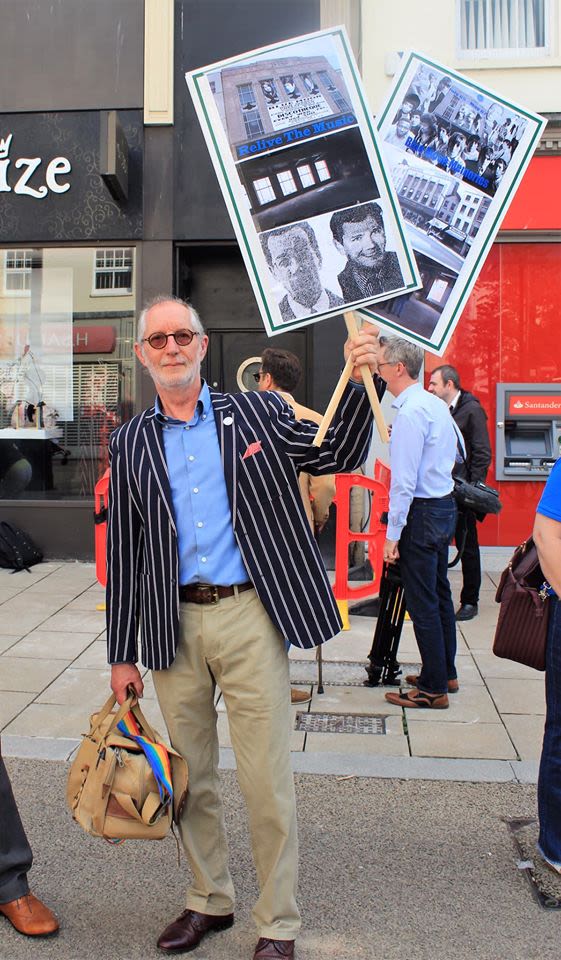
Kevin Turfrey at the Blue Moon plaque unveiling and below in his mod days. Image: The Blue Moon Cheltenham.Teen & Twenty Rendezvous Facebook group
Kevin Turfrey at the Blue Moon plaque unveiling and below in his mod days. Image: The Blue Moon Cheltenham.Teen & Twenty Rendezvous Facebook group
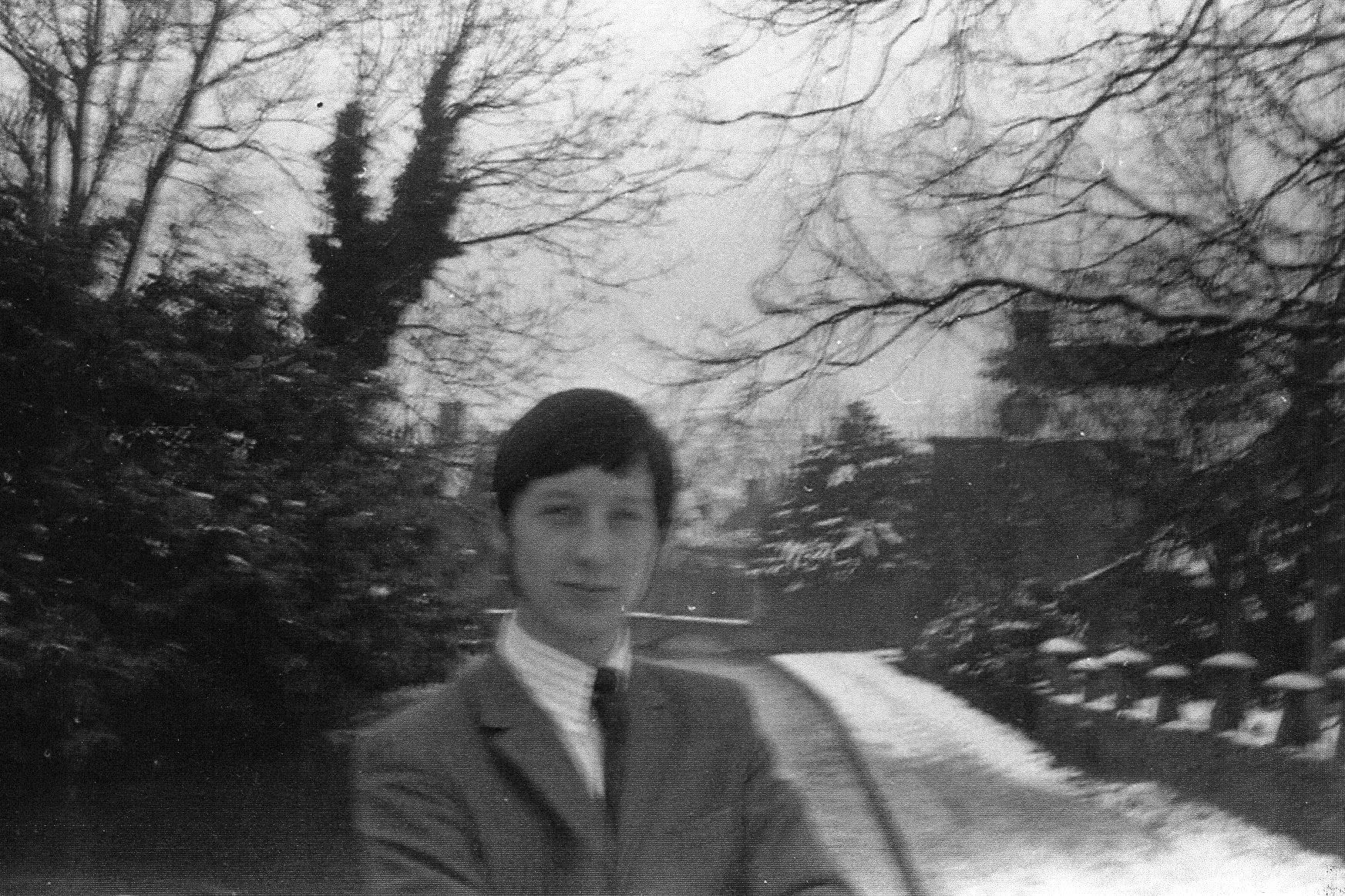
Image provided by Kevin Turfrey
Image provided by Kevin Turfrey
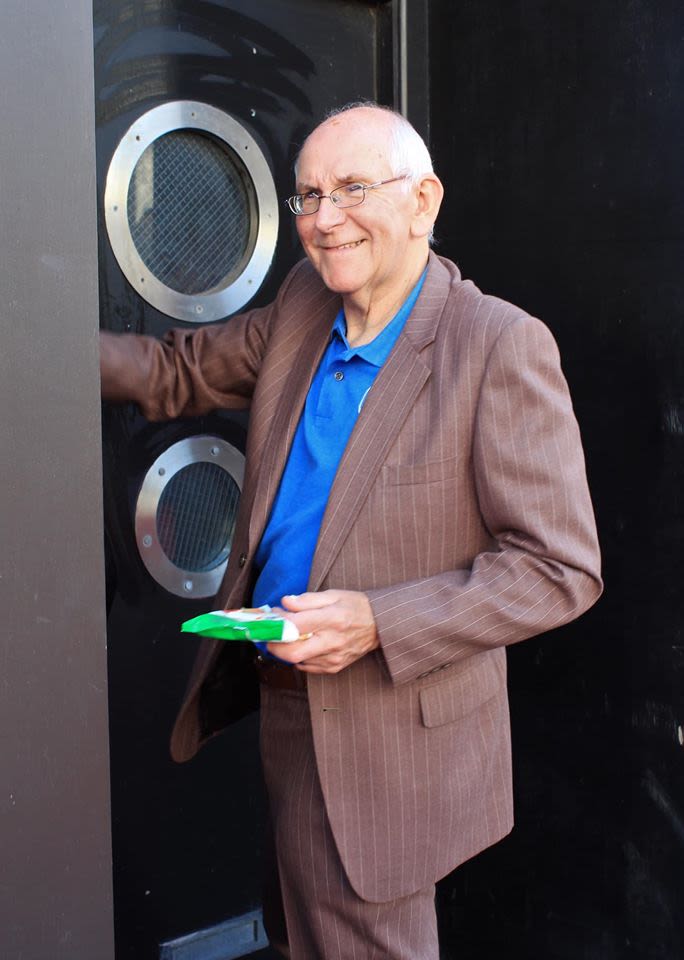
Christopher Stanbury stands at the old entrance to the club. Image: The Blue Moon Cheltenham.Teen & Twenty Rendezvous Facebook group
Christopher Stanbury stands at the old entrance to the club. Image: The Blue Moon Cheltenham.Teen & Twenty Rendezvous Facebook group
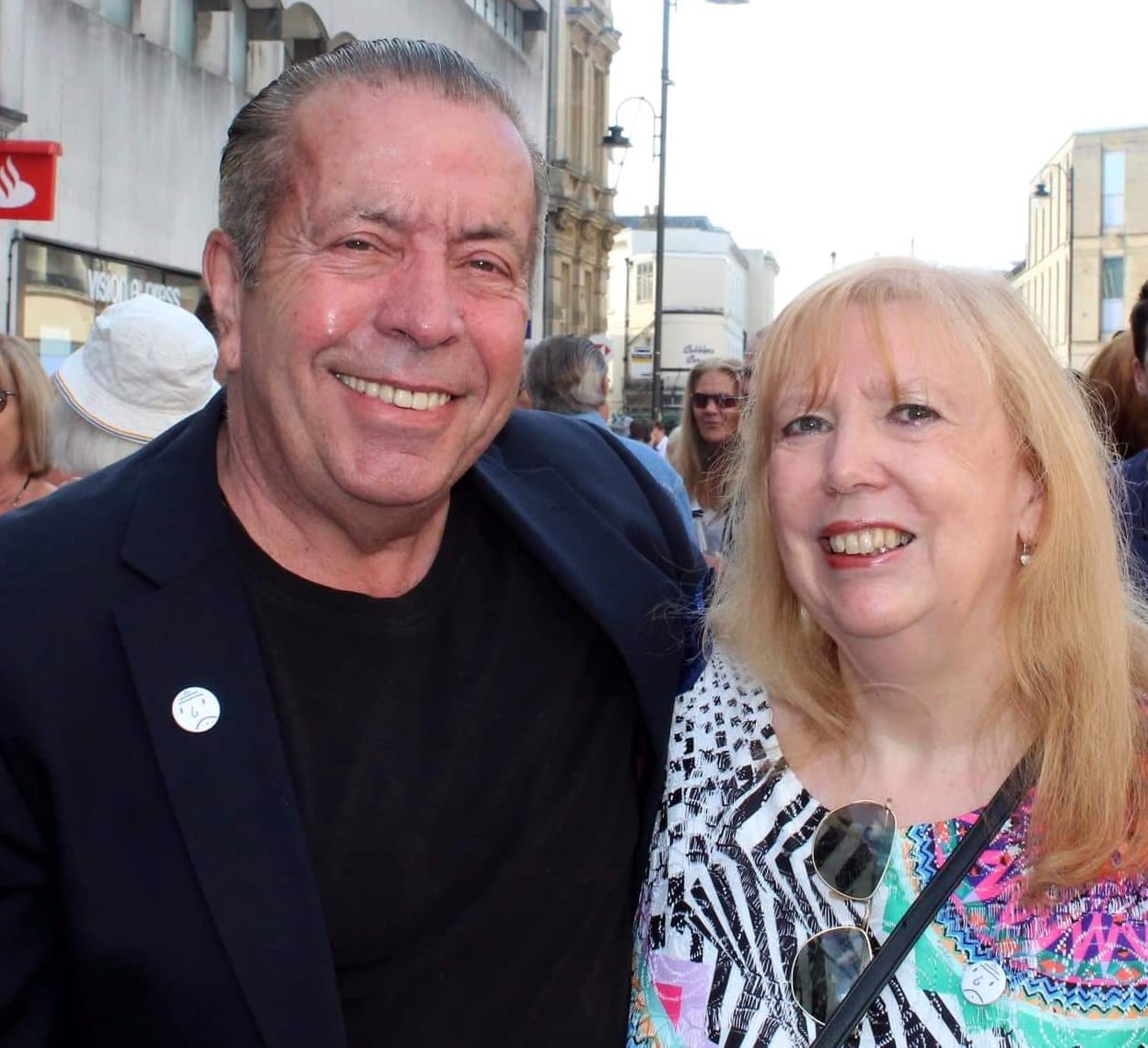
Charles Scarrott and Sue Brooks. Image: The Blue Moon Cheltenham.Teen & Twenty Rendezvous Facebook group
Charles Scarrott and Sue Brooks. Image: The Blue Moon Cheltenham.Teen & Twenty Rendezvous Facebook group
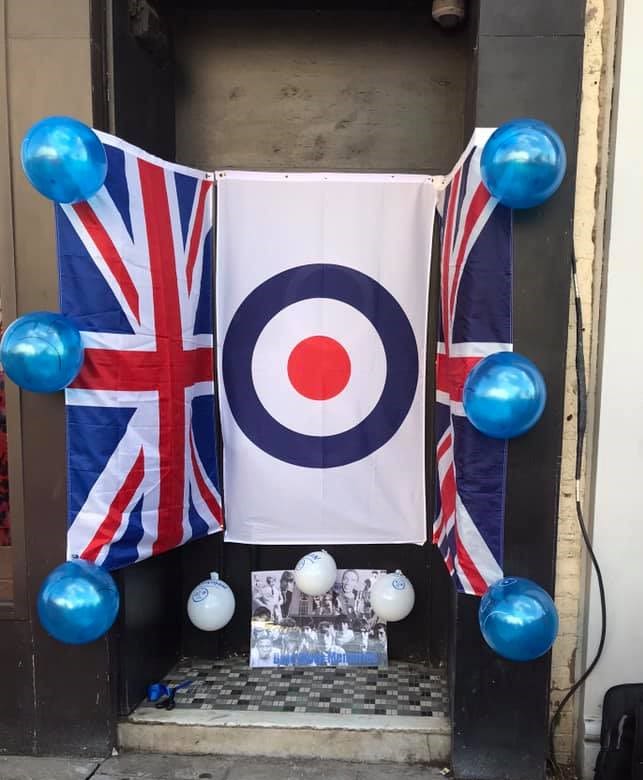
Image courtesy of The Blue Moon Cheltenham.Teen & Twenty Rendezvous Facebook group
Image courtesy of The Blue Moon Cheltenham.Teen & Twenty Rendezvous Facebook group
The club and the times hold a treasure trove of memories for the old members and some still regard their mod days as the best of their lives. With a book about the club and the town's mod history in the pipeline, it won’t be too long before a new lease of life is brought to the Blue Moon and to the 1960s mods of Cheltenham, celebrating and preserving precious memories for them and generations to come.
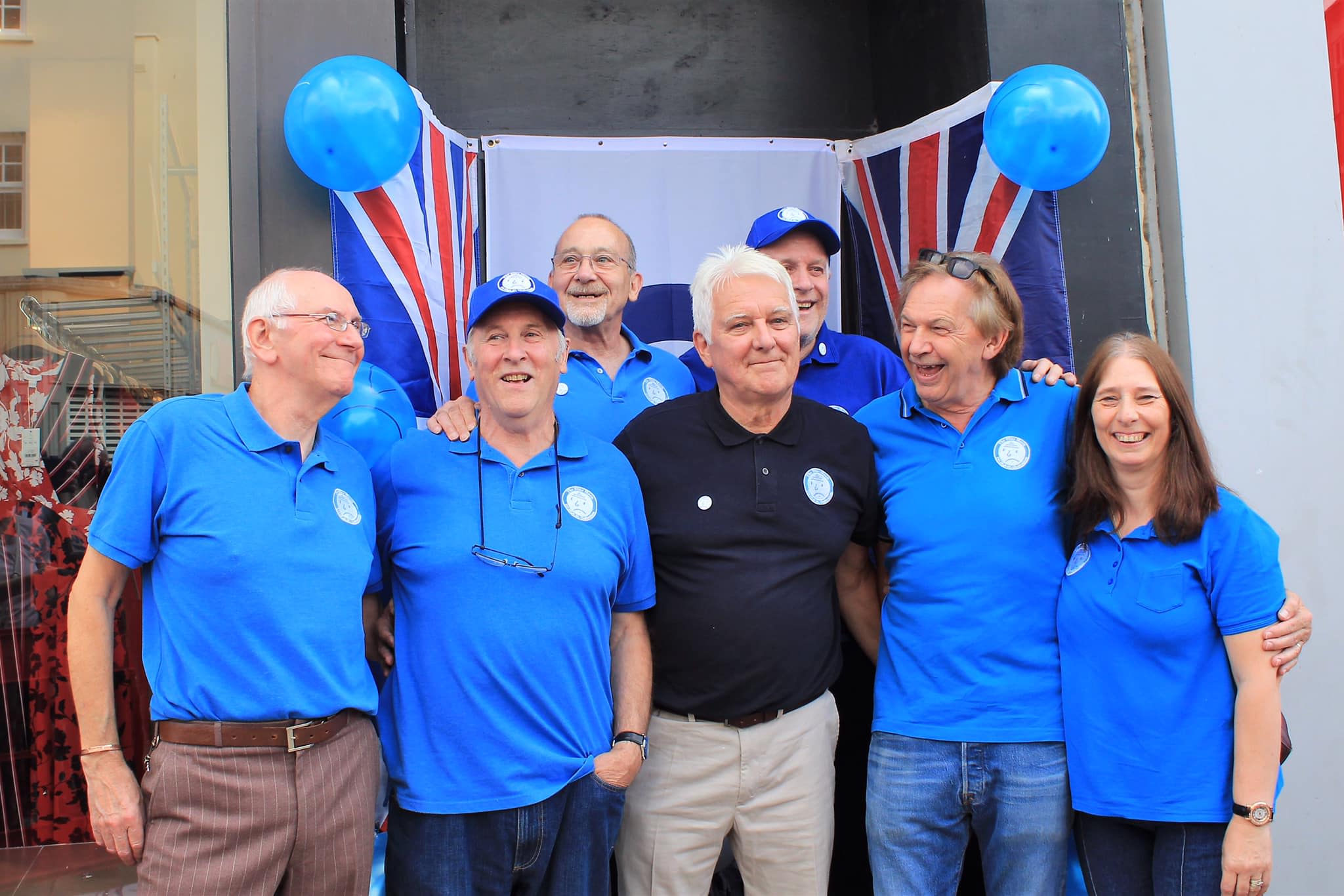
Image courtesy of The Blue Moon Cheltenham.Teen & Twenty Rendezvous Facebook group
Image courtesy of The Blue Moon Cheltenham.Teen & Twenty Rendezvous Facebook group
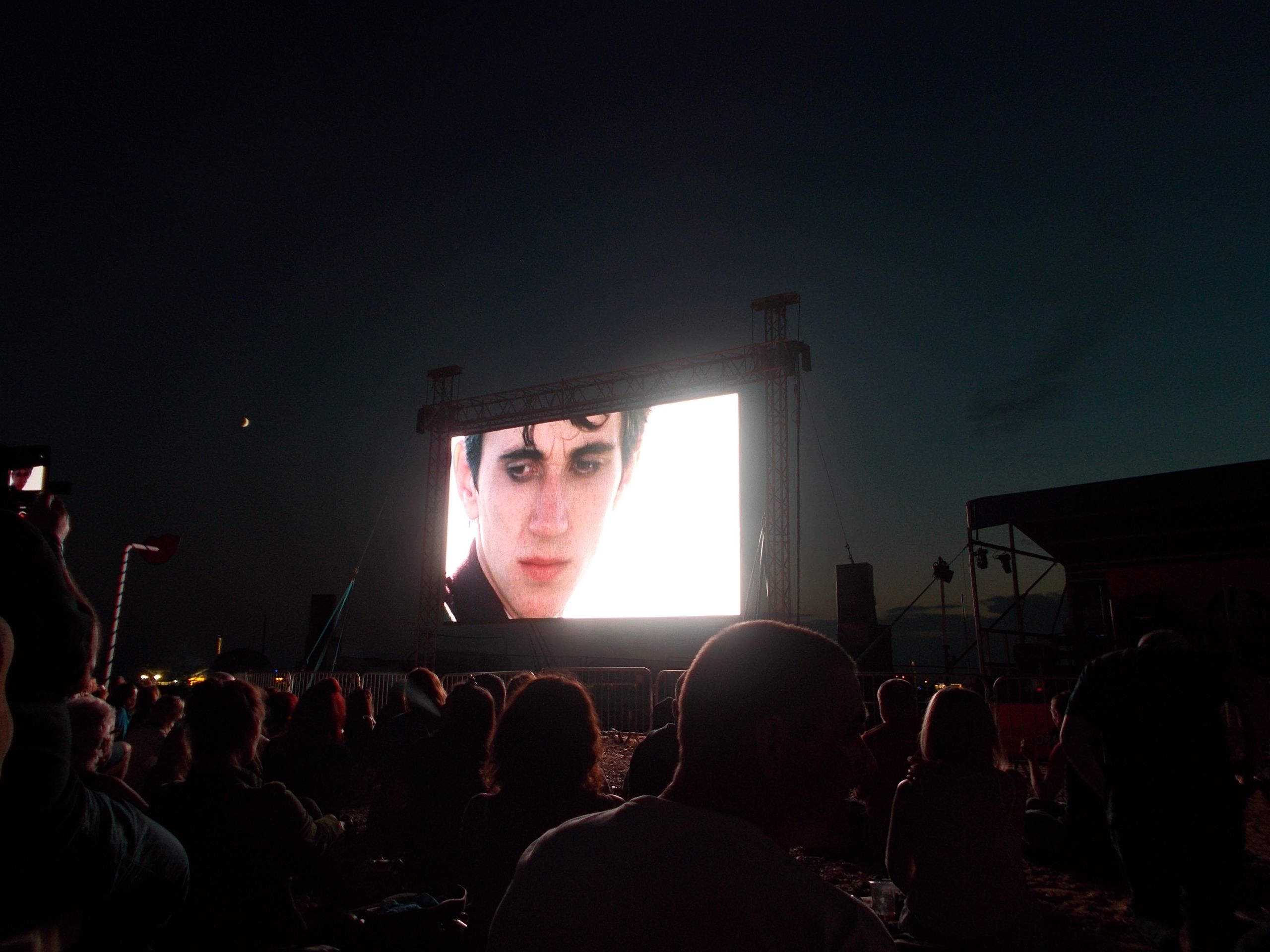
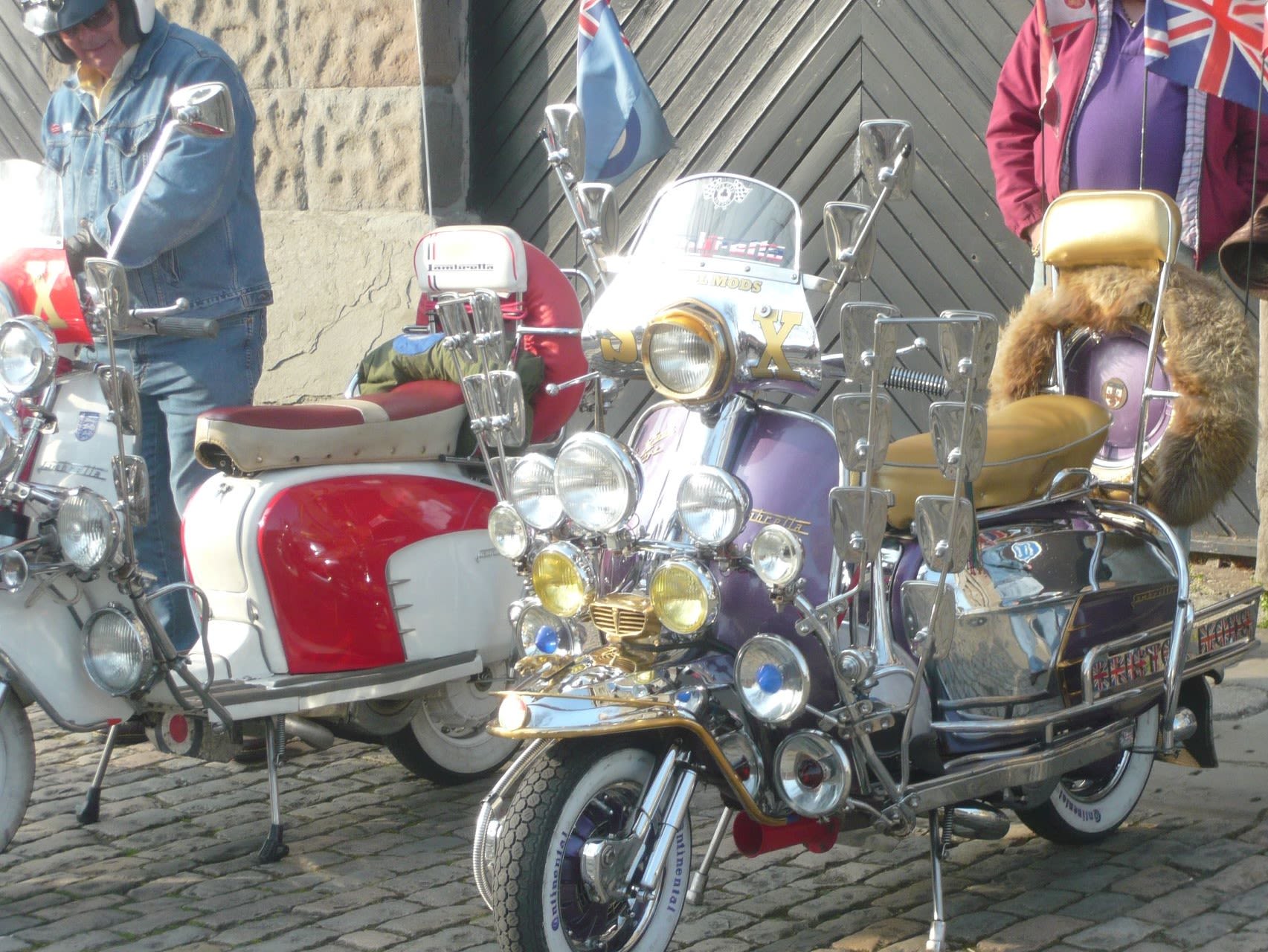
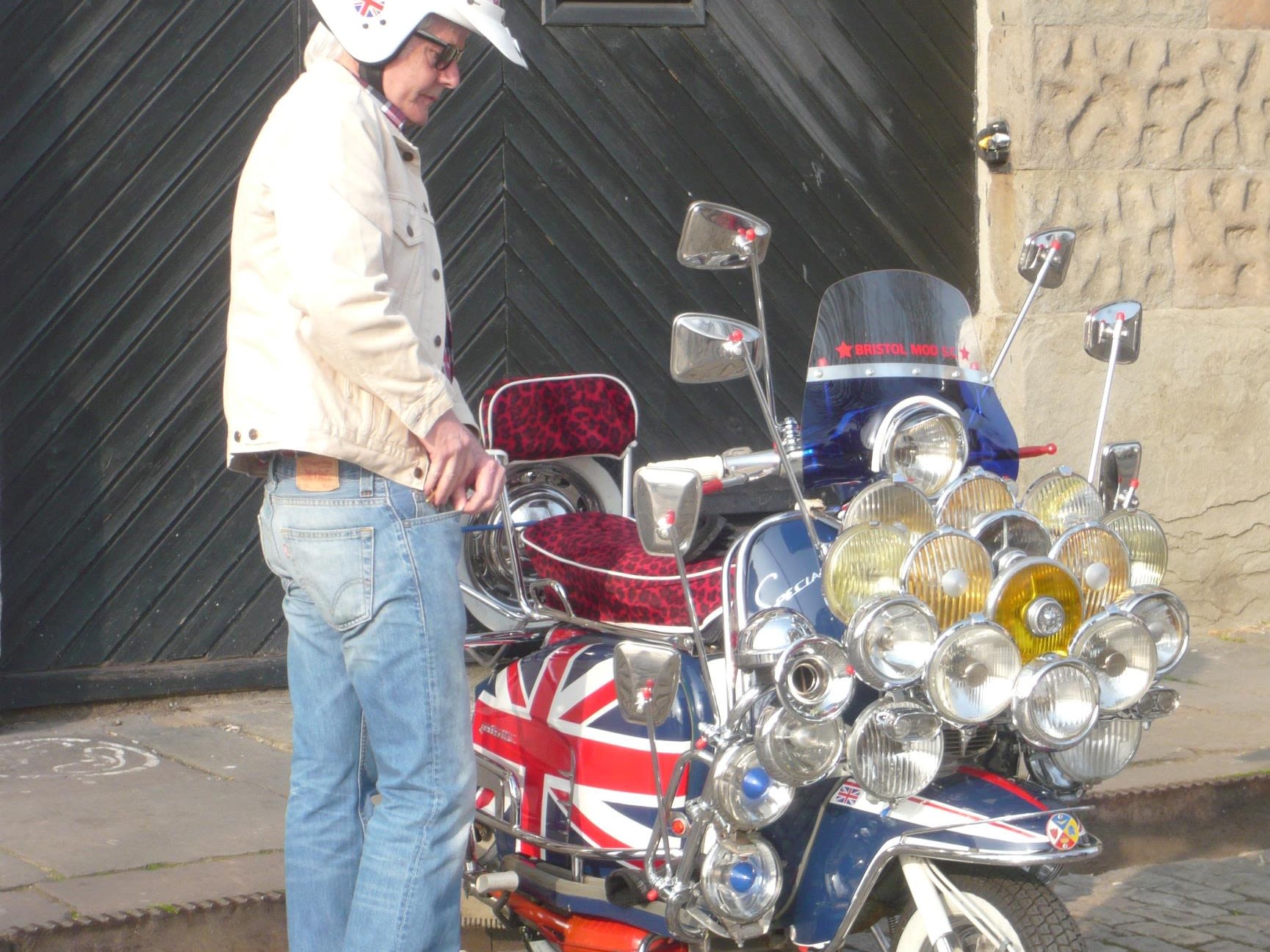
Acknowledgments: Thank you to Neil Leighton, Patti Garland, Graham Williams, Claire Mahoney, The Blue Moon Cheltenham.Teen & Twenty Rendezvous Facebook Group, Kevin Turfrey, Richard Goddard, Christopher Stanbury, Dave 'Jacko' Jackson, Michael Williams, Charles Scarrott, Sue Brooks, Catherine Jones, Robin Brooks and the Midlands Archive for Central England (MACE) for all their help and support with this project. Images where not otherwise credited in 'An Enduring Subculture' Heather Buckley Flickr and Luca Anasta - unsplash.com
References
Potter, P., 2018. Mods - A Way Of Life. 1st edition. Darlington, England: Carpet Bombing Culture.